Her på Blåvand's blog bringes korte nyheder i dagbogsformat om livet og hændelser på fuglestationen.
Se indlæg fra måned: feb. (2)mar. (31)apr. (30)maj (31)juni (10)juli (22)aug. (31)sept. (30)okt. (31)nov. (15)
Efterårssæsonens sidste dag
Vi fire frivillige der er på stationen til efterårssæsonens afslutning i dag takker af og ser tilbage på en god sæson i både træktælling og ringmærkning samt vores personlige oplevelser på Blåvand Fuglestation dette efterår.
Så blev det den femtende november. Dagene er blevet kolde, fugletrækket ebber så småt ud og vi er ved at lukke stationen ned for vinteren. Ligesom ringmærkerne har jeg (Sverre) også brugt de sidste par dage på at kvalitetssikre data. I min tid på station har vi på morgenobsen indsamlet hele fem notesbøger med tætskrevne sider fyldt med data. Så det er ikke bare data jeg har siddet og kontrolleret, det er minder og vidner om vores tid på stationen. Fem bøger med tætskrevne minder og spændende fugle.
Helt fra sæsonens start den 12. juli, hvor træktællingen blev udført af Thomas Kristensen, Henrik Böhmer og David Manstrup og frem til nu. Vi har været mange frivillige på stationen i år. Jeg har både nydt den første måned med Estelle Cumin, Martina Hildebrand og Morten Jenrich og i særdeleshed også min tid med de lidt mere faste frivillige som Lua Koplin, Lise Mastrup, Mathilde Lundt Larsen, Gustav Jelert, Anna Beluga Gade-Jørgensen og Oliver Laursen. Det har været en voldsomt spændende og hyggelig tid på stationen, hvor jeg har følt mig enormt priviligeret af at se (næsten) hele efterårssæsonen og det artsskifte som det har bragt.
Der er et fantastisk fællesskab der er omkring Blåvand Fuglestation, både med de frivillege, stationens styregruppe og alle de gæster som besøger stationen. En helt enorm lærerig oplevelse hvor man virkelig kan få et adrenalinskud med fugleviden direkte ind i hovedpulsåren:)
Hvis man kigger på de fugle der er blevet set herude er det vist også en ganske fin sæson. Sæsonen startede med den blå glente, derefter en skøn dag i bunkeren med brilleand og lille stormsvale. Middelhavssølvmåge, 2 Hvidvingede måge og 2 sabinemåge. 3 småkjover, stor stormsvale, odinshane og tajgapiber. Og selvfølgelig godt med de klassiske blåvand-specialitetet såsom hvidbrynet løvsangere (mange), 2 fuglekongesangere, 3 dværgværlinger, sodfarvede skråper, en almindelig skråpe. fem steppehøge, 2 lapværlinger, en snes store korsnæb og selvfølgelig en røvfuld søkonger. Og det er vel og mærket kun fugle på morgenobsen;)
Derudover kan man så lægge en himalayasanger, en iberisk sanger og en cettisanger på som alle tre gæstede nede omkring Tipmosen og Grønningen. Samt en brun sule i Esbjerg Havn og en Ørkenstenpikker i Hvide Sande som vi også kørte på. En voldsomt stjernespækket sæson!
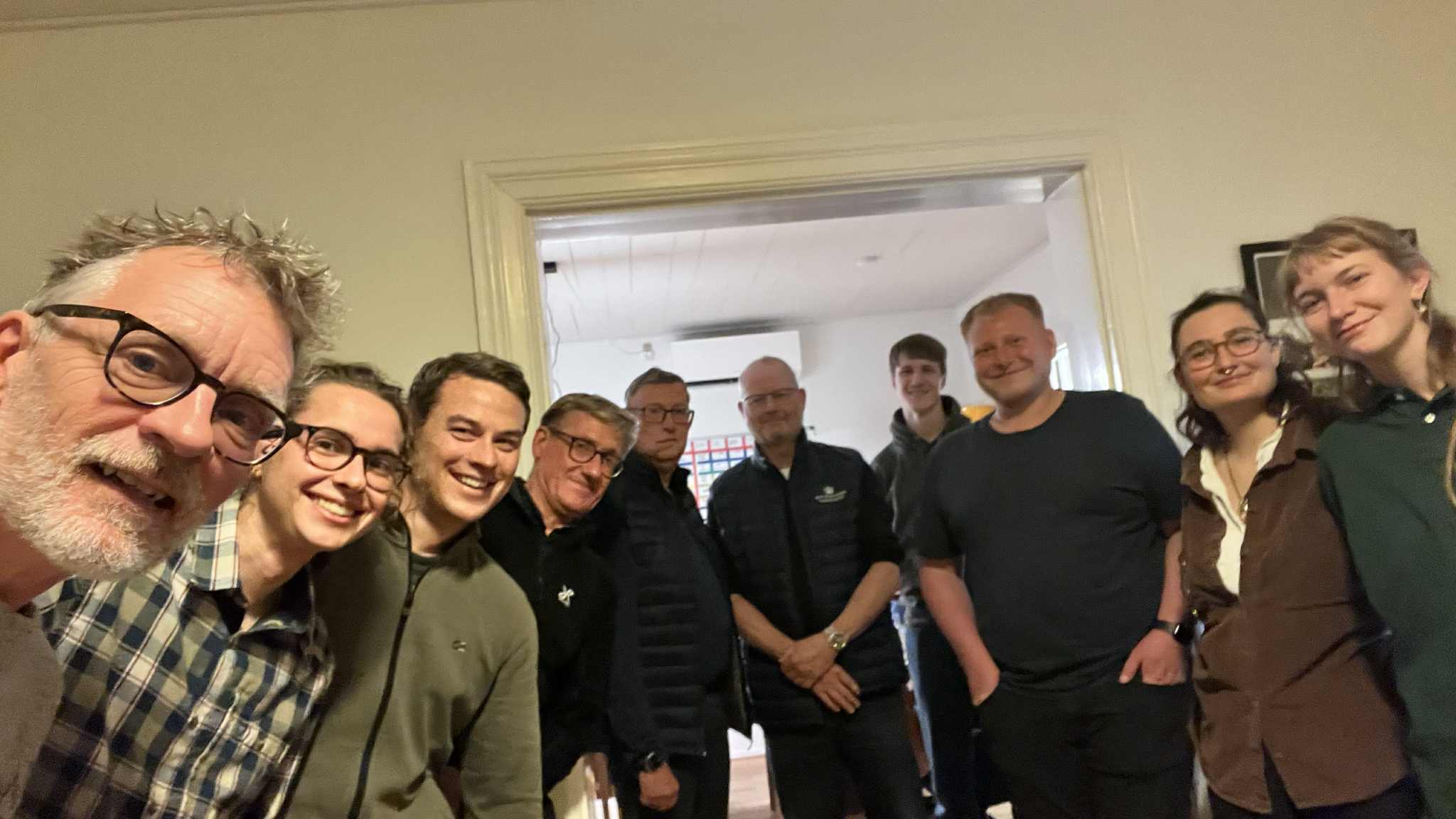
De frivillige og det meste af BLF's bestyrrelse til farvelmiddag
Jeg har virkelig nydt min tid på stationen og takker mange gange alle der har besøgt BLF, læst med hjemmefra, været frivillige eller på anden måde bidraget til efterårssæsonen 2025. Tak for nu og de bedste hilsner,
- SDP
For mig er et ophold på Blåvand Fuglestation virkelig som at tage en dyb indånding. Jeg elsker jo at se på fugle og finde fugle og her får man netop den chance. Jeg blev netop student i sommers, og mit sæsonarbejde holdte op i uge 42. Så efter en tid med pligter, skulle jeg selvfølgelig på ferie. Og det er sådan jeg opfatter Blåvand Fuglestation. Nogen tager på ferie i udlandet i store hoteller og sådan noget, men jeg får den samme følelse af at tage et ophold på stationen. Det bedste ved mit ophold var helt sikker at være omkring ligesindede og at lære at være lidt mere selvstændig, noget jeg ikke rigtig har prøvet før, da jeg hele tiden havde boet hjemme. Men jeg takker Blåvand Fuglestation og DOF for at give mig denne fantastiske mulighed. Jeg komme ikke til at glemme dette ophold!
- OLA
With the end of the season reached, these final days of ringing have brought back so many memories from the autumn months. Among the highlights were a redstart (rødstjert) yesterday and a bullfinch (dompap) today, species that reminded me of September, and fittingly, our very last ringed bird symbolized the season perfectly: a blue tit (blåmejse)! Overall we ringed 2280! The blue tits definitely tested our patience, skill, and stress tolerance, but they also pushed us to grow and work together under pressure, because handling 400 angry blue monsters at once is not for the faint-hearted.
With an overall total of 5306 and over 50 species of birds ringed in he autumn season, blue tits (blåmejse) were by far the most ringed species of the season with a number of 2210, coal tits (sortmejse) with 446 and goldcrests (fuglekonge) with 432 following behind. Among the most special birds we encountered were definitely the Pallas’s leaf warbler (fuglekongesanger), the yellow-browed warbler (hvidbrynet løvsanger), and the red-breasted flycatcher (lille fluesnapper). And for me personally, some unforgettable highlights were the individuals we caught only once: a hawfinch (kernebider), a red crossbill (lille korsnæb), a fieldfare (sjagger), and a wheatear (stenpikker), each one a rare and exciting moment of its own.
One of my personal favourite days was the 18th of October, when we caught our first Pallas’s leaf warbler, had an abundance of blue tits and the beautiful long-tailed tits (halemejse), along with many other incredible species. I vividly remember the joy that Anna-Beluga, Mathilde, and I felt catching our first rare bird. It was just as wonderful to have the whole team helping us with the blue and long-tailed tits in the station garden.
Watching the ringers learn, develop new skills, and grow so quickly has been an absolute joy for me. I’m truly proud to have been part of such an amazing team this autumn. A huge thank you to Bent and Henrik, as well as Thomas, Sverre, Oliver, Gustav—and of course the fantastic ringing team: Lise, Anna-Beluga, and Mathilde!
- LK
Min tid på stationen har bragt mange gode fugle og en masse lærerig tid i min oplæring som ringmærker. Jeg har mærket efteråret stærkt med dets foranderlige vejr og fugletrækkets skift gennem september, oktober og november. At leve og arbejde ud fra solens lys og vejrets uforudsigelighed har været helende og også spændende, fordi man må følge med rytmen i naturen og hvad der gives af fugle derfra. Efterhånden som sæsonen forløb, fik jeg større forståelse for disse skift og reaktioner mellem vejret, naturen og fuglene i Blåvand, også gennem den enorme vidensbank af erfaringer der er i de, der færdes på og arbejder på stationen. Det var meget indsigtsfyldt at kunne bruge denne viden i ringmærkningen, selvom vi også alligevel blev overrasket - især omkring udviklingen af mejse-invasionen, der gjorde dette denne sæson til rekorsæson for blåmejser i stationens historie. Jeg ser det som en helt speciel oplevelse at holde fugle i hånden og gøre dette med nænsomhed, og det er en vigtig opgave at ringmærke og således bidrage til forskning i fugletrækket.
Når der ikke kunne ringmærkes, og det rigtigt ruskede i marehalmen på klitterne og lyngen på heden, var jeg ofte også med på morgenobs og fik også mange begivenhedsrige morgener der. Eller jeg vandrede rundt i mosen og i klitterne og kiggede på planter og lyttede fugle. Også de store dage med spændende fund i Blåvandsområdet gav mig sus og vindpust i cykelhjulene. Det har været fantastisk noget så simpelt som at være udenfor i mange timer hver dag og tilbringe tid med at sanse og opleve fugletrækket.
At få alle disse fugle i hånden igennem sæsonen hærdede mig og gav mig mere selvsikkerhed i ringmærkningen under Lua Koplins og Henrik Böhmers kompetente og tålmodige lære. Jeg glæder mig til at fortsætte med at ringmærke og komme tilbage på Blåvand Fuglestation, som har betydet meget for mig som hjem, lære- og arbejdsplads disse måneder.
En personlig favorit for mig i ringmærkningen er skovsneppen, der kom forbi denne sidste uge.
- MLL
Den sidste standardiserede ringmærkningsdag gav i dag disse fugle:

Folk på stationen: Lua Koplin, Sverre Dahl Porsgaard, Mathilde Lundt Larsen, Oliver Laursen
Vinteren kommer
Morgenobs
Sæsonens næstsidste morgenobs satte os på prøve. De mange gæs kom langt væk, og de kunne ikke alle bestemmes. Riderne og dværgmågerne er også aftaget, hvor der var få dværgmåger og ingen rider. Ja man kan virkelig mærke at vinteren er på vej, småfuglene er trukket og vinterfuglene er efterhånden på vej herhen. Vi havde ca. 30 snespurve i løbet af dagen, som kom i deres smukke hvide nuancer langs de yderste klitrækker. En gråstrubet lappedykker kom i den sidste time som gav os en lille smule håb for resten af obsen, men det rystede ikke særlig meget fra sig. Dagens fugl må altså gå til snespurverne der kommer med deres smukke fløjten og nuancer.
- OLA
Ringmærkning
Sæsonens næstsidste standardiserede dag kom os flot i møde, hvor mange af sæsonens arter gæstede os - som hilste de os godt på gensyn. Således fik vi en mindre gruppe blåmejser og musvitter, samt en sortmejse. Derudover endnu en rødtoppet fuglekonge, som har haft et suverænt godt år i Blåvand. Også en 1k hun stor flagspætte kom forbi.
Tilmed en 1k han rødstjert - en sen ankommen.
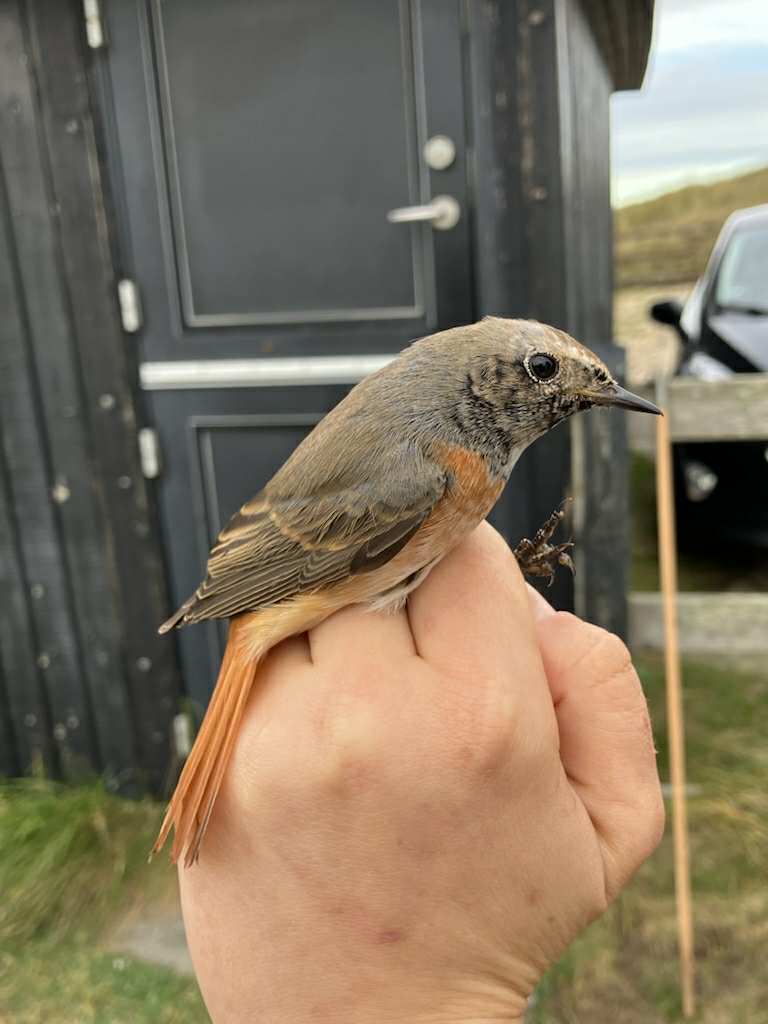
1k rødstjert han. Billede: Mathilde Lundt Larsen
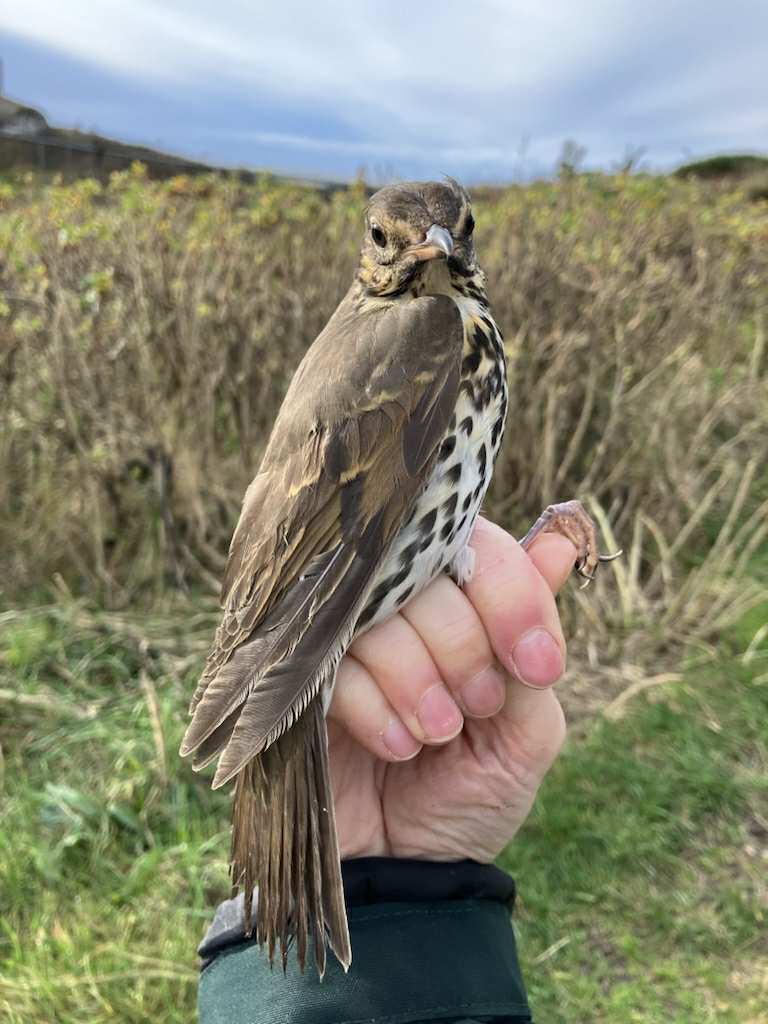
1k sangdrossel. Billede: Mathilde Lundt Larsen
Således går sæsonen på hæld med en flot sidste dag - 53 nye ringmærkede fugle på en novemberdag er ikke så ringe. Jeg ser tilbage på sæsonen med glæde over alt, jeg har lært og alle de fugle vi har haft.
Om aftenen havde vi afslutningsmiddag med styregruppen for stationen og fejrede en god sæson.
- MLL

Folk på stationen: Lua Koplin, Sverre Dahl Porsgaard, Mathilde Lundt Larsen, Oliver Laursen
Little gulls and kittiwakes
Morgenobs
Dagen i dag stod på sydvestenvind med hele 11 meter i sekundet. Vinden ruskede i hybenbusken omkring os og det bed i fingrene. stadug holdt vi fast i teleskoperne og gennemførte endnu en dejlig morgenobs. Arts diversiteten var ikke særlig høj i dag, og ligeledes gik det med kvantiteten af fugle... ikke alverden. Men i løbet af morgenen tog det til med mængden af både ride og dværgmåge. Særligt nød vi en 1k ride som kom over stranden og legede rundt i bølgekanten i et par minutter inden den fløj videre sydpå. Vi havde også nogle lækre flokke af dværgmåger og lidt rider i nærheden. Vi synes specielt at de blandede flokke var sjove. Tågen var dog stadig lige i nærheden, hvilket for en gangs skyld spillede for vores fordel eftersom det pressede mågerne tættere på os. Dagens fugl var dog ikke nogen af mågerne men en meget sen splitterne, en 1k fugl i vinterdragt. Den burde for længst have været i Afrika. Alt i alt en sjov og underholdende dag her i Blåvand:)
- SDP
Ringmærkning
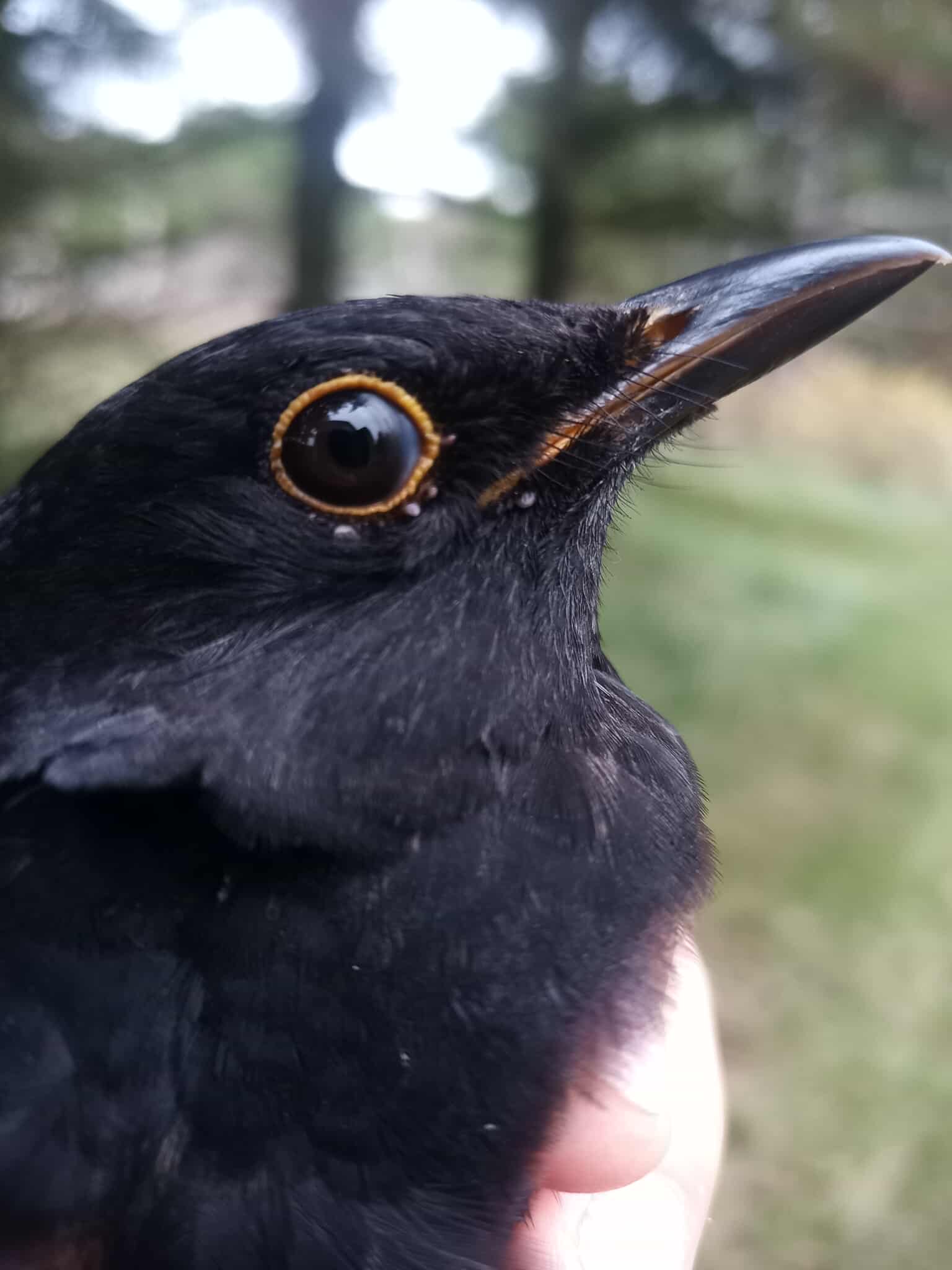
Blackbird young male.

Two blue tits to remind of us of what we have endured and enjoyed.
- LK
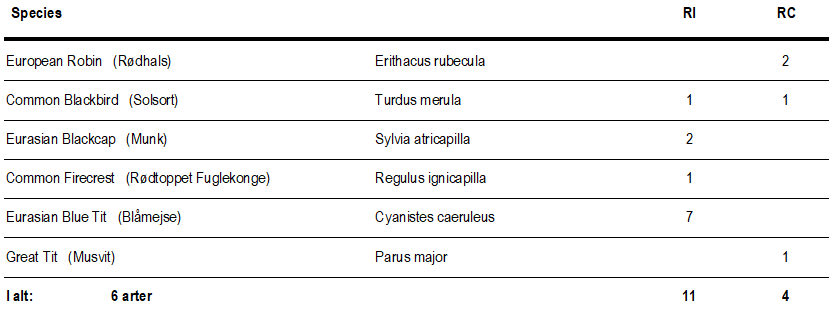
Folk på stationen: Lua Koplin, Sverre Dahl Porsgaard, Mathilde Lundt Larsen, Oliver Laursen, Lise Mastrup
Dejligt at blive blæst lidt igennem
Morgenobs
Det er simpelthen stadig vådt og mildt tåget herude. Sigtbarheden i dag lå nede på de omkring tre til fire kilometer og blen kun periodisk ringere når der kommer byger ind fra havet. Vinden kom fra syd-sydøst med en buldrende elleve meter i sekundet. Så i det mindst er det ikke vindstille mere. Oliver og Jeg overlevede de første to timers standard tid inden at sigtbarheden blev så dårlig (og vi blev så våde) at trækket gik næsten fuldstændig i stå. Inden da nåede vi dog at have en ret dejlig morgen. Vi startede med en gråstrubet lappedykker, en sortstrubet lom og en hvinand. Vi havde derudover i alt otte havlitter og fire alke. Bestemt ikke dårligt, sigtbarheden taget i betragtning. I dag havde vi også fornøjelsen af tre voksne suler som fløj op og ned ad revet et par gange. Dem er jeg langtidsfan af, det er bare en lækker fugl med sit store gule og sorte vingefang. En skøn dag, og forbavsende produktiv fra morgenstunden. I morgen bliver det samme, men måske en smule mere tørt:)
- SDP
Ringmærkning
En regnvåd og blæsende morgen på det vestligste punkt betød, at nettene forblev lukkede i dag. Vi håber på at vende stærkt tilbage i morgen og få revanche mod novembervejret! De forhenværende dages vindestille forhold er dog vendt.
Vi fik brugt regnvejret på at tjekke mere data inden sæsonafslutningen. Da der blev ophold imellem bygerne cyklede jeg en tur til Grønningen og forbi Enders Kapel. Det gav anledning til at reflektere over efteråret her i Blåvand - og hvillket efterår, det har været! Jeg har været meget nært hele sæsonen og mærket fugletrækkets forandringer, men alligevel føles det næsten overraskende at se, hvordan løvtræernes sidste blade falder nu. Det føles særligt at besøge de steder, der har været med til at forme mit efterår i Blåvand i disse sidste sæsondage.
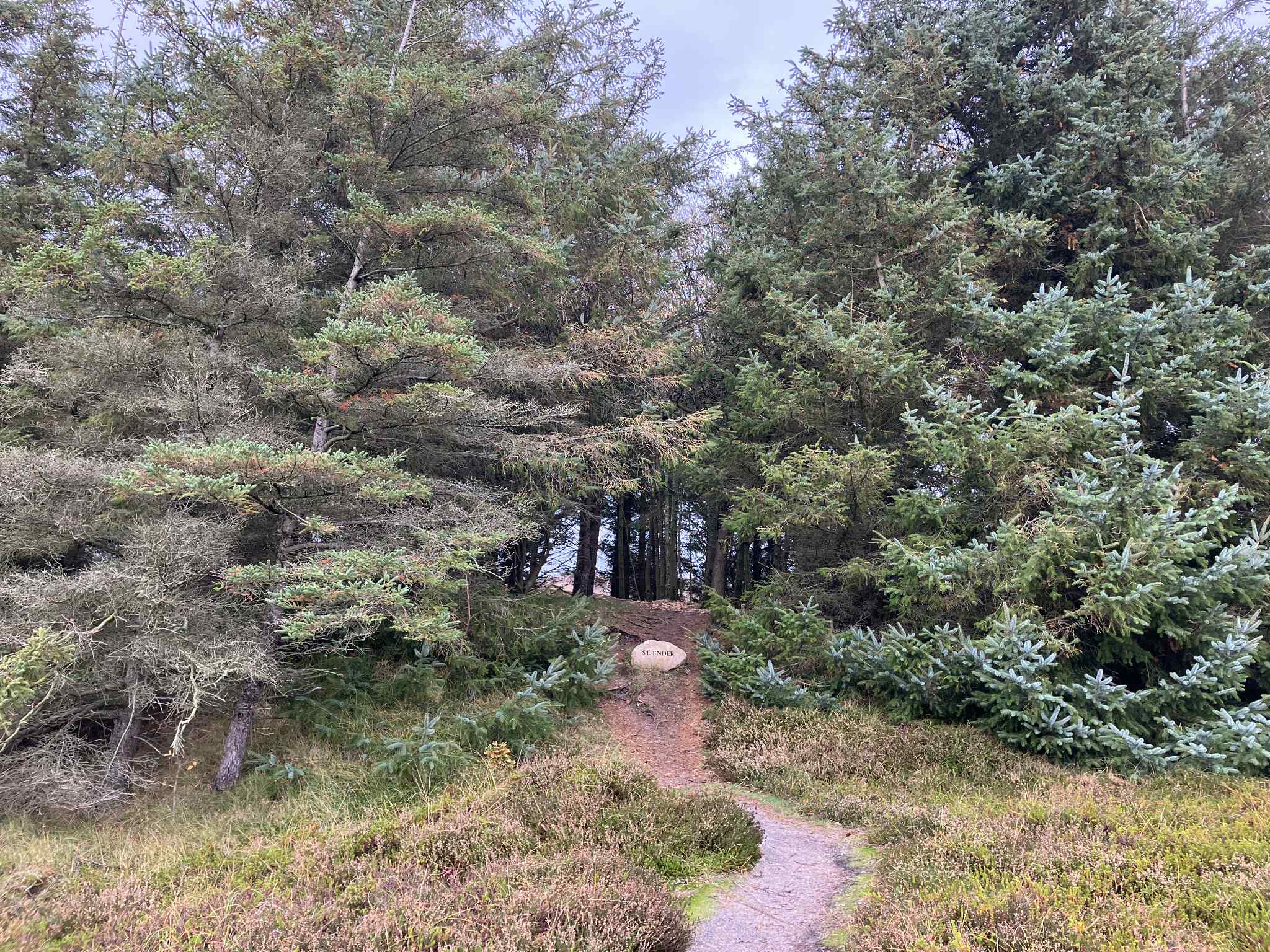
Enders Kapel - her mange fuglekonger denne eftermiddag. Billede: Mathilde Lundt Larsen

Fiskehejre ved Reginevej. Billede: Mathilde Lundt Larsen
Her til aften ankommer Lise til stationen på et visit fra Skagen. Vi glæder os til at hilse hende tilbage på stationen i et par dage!
- MLL
Folk på stationen: Lua Koplin, Sverre Dahl Porsgaard, Mathilde Lundt Larsen, Oliver Laursen, Lise Mastrup
Kitiwakes and data control!
Observation
With some slow misty rain we got ready for the day in 'hullet'. Before we had even sat down the air was filled with the sound of waxwings, but they never really made any sound later in the day. Slowly we saw the usual subjects (birds) but today we were lucky with the kitiwakes flying closeby so we could see this seabird closely, a bird that usually is far away in the horizon. Soon all the seagulls flew up in the air, a symbol showing a predator is closeby. Today that predator was a second calendar white-tailed eagle that took a break on the beach. I (Oliver) had hoped for a pomarine jaeger though. When it flew away the seagulls flew back to the beach aswell, there was a strange gull. Its build was like a caspian gull, but the colour and patterns showed herring gull. We deciede that it must have been a hybrid between these two, a first for me. The bird of the day must go to the waxwings that are just now showing up in blåvand, and the day is indeed accepted as a good morning obs.
-OLA
Ringing
As there was moderate rain all through out the morning, we did not ring and instead used our time with something way more fun: Data control!!
As the official Autumn Migration Ringing Season is coming to an end, it is important to regularly go over all our collected data and make sure that everything is in oder and there are no abnormalities in the clean data set. This meant a cozy day for Mathilde and myself (Lua). With a lit fire in the fireplace, alot of coffee and tea, as well as many home made snacks and some walks in the rain as our little break, we made it through most of the data!
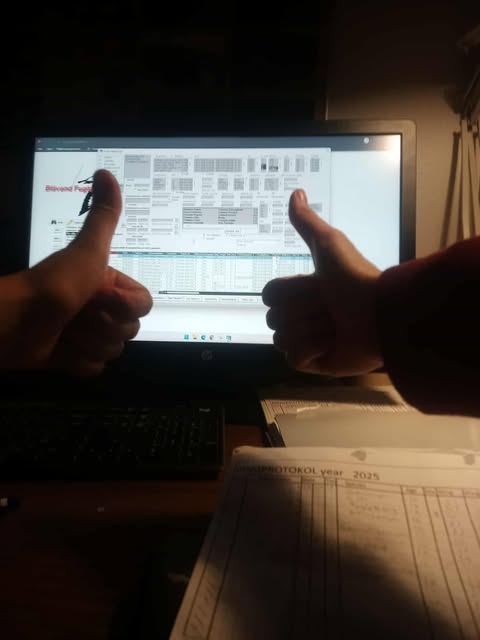
-LK
Folk på stationen: Lua Koplin, Sverre Dahl Porsgaard, Mathilde Lundt Larsen, Oliver Laursen
Blåvand melder tåge
Morgenobs
Da vi stod op i dag og kiggede ud kunne vi kun lige se foden af Blåvands stolte fyrtårn. sagtbarheden var derfor helt uovertruffent dårlig. Jeg (Sverre) tog dog alligevel mit bedste tøj på og drog ud på min sandbanke for at se om man overhovedte kunne se stranden... det kunne man ikke. På stranden og fyrtårnet var pist væk, dækket af tåge så tyk at man kun kunne skære igennem den med en vinkelsliber. Jeg sad ude på klitten ved bunkeren o godt og vel en time, hvori jeg kun så fem bogfinker der hurtigt trak forbi mig inden de forsvandt ind det grå skær på ny. Tja det blev da også til fem stære. Så dagens fugl er enten stær eller engpiber, det må I selv bestemme. Det blev desværre ikke til andre fugle i dag, da jeg efter en imes kedsommelig ventetid besluttede mig for at gå hjem til stationen langs stranden. Fra stranden kunne man næsten se havet, så jeg fik da også set lidt enkelte sølvmåger. Men meget andet kan jeg ikke præstere i dag. Tågen lettede først engang kl 13.
Det var dog alligevel en hyggelig dag hvor jeg havde tid til at gå i køkkenet og gennemgå noget af den data vi har indskrevet i DOF-basen de seneste måneder. Som altid en god dag i blåvand:)
- SDP
Ringmærkning
I morgenmørket stod tågen tyk omkring huset og omkring fyret - man kunne kun ane fyrets lyskegler der oplyste tågens dugdråber i luften med deres rytmiske omdrejninger. Efterhånden som solen stod op, kunne jeg ane mere af fyret, men det forsvandt hurtigt i tyk tåge igen, og forblev gemt det meste af dagen. I denne tåge kunne vi vandre omkring hjørnerne ved nettene og ikke vide, hvad vi skulle forvente i den stilheden efterladt i dug og stille vind.
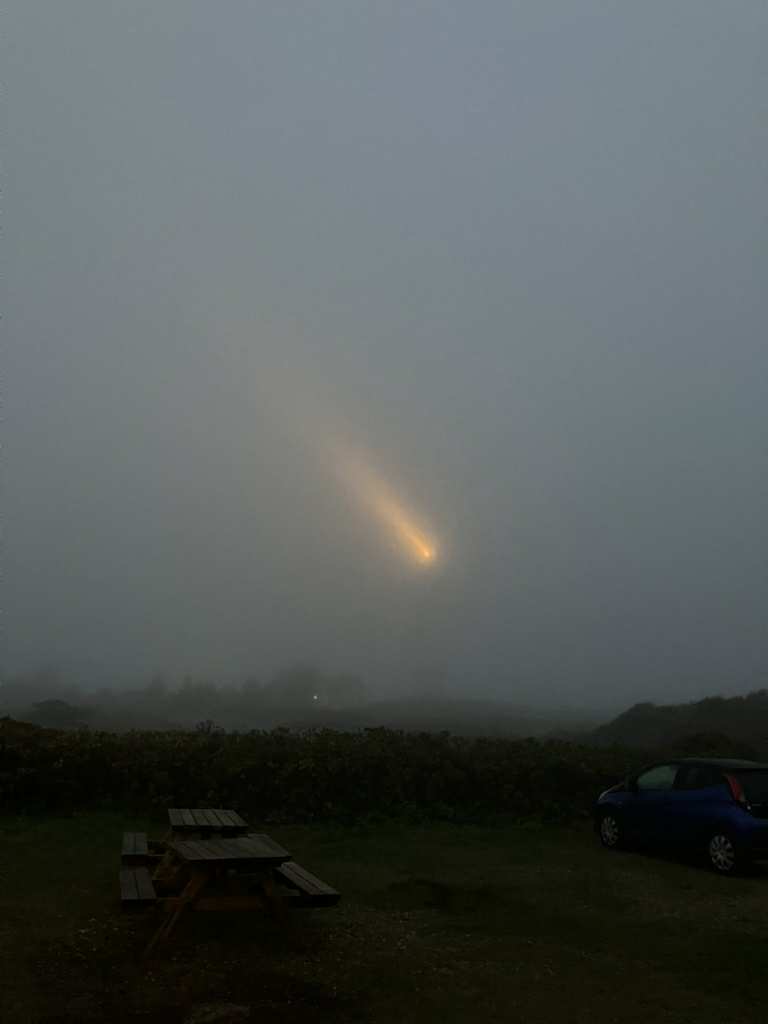
Fyret lyser vej i de tidlige morgentimer. Billede: Mathilde Lundt Larsen
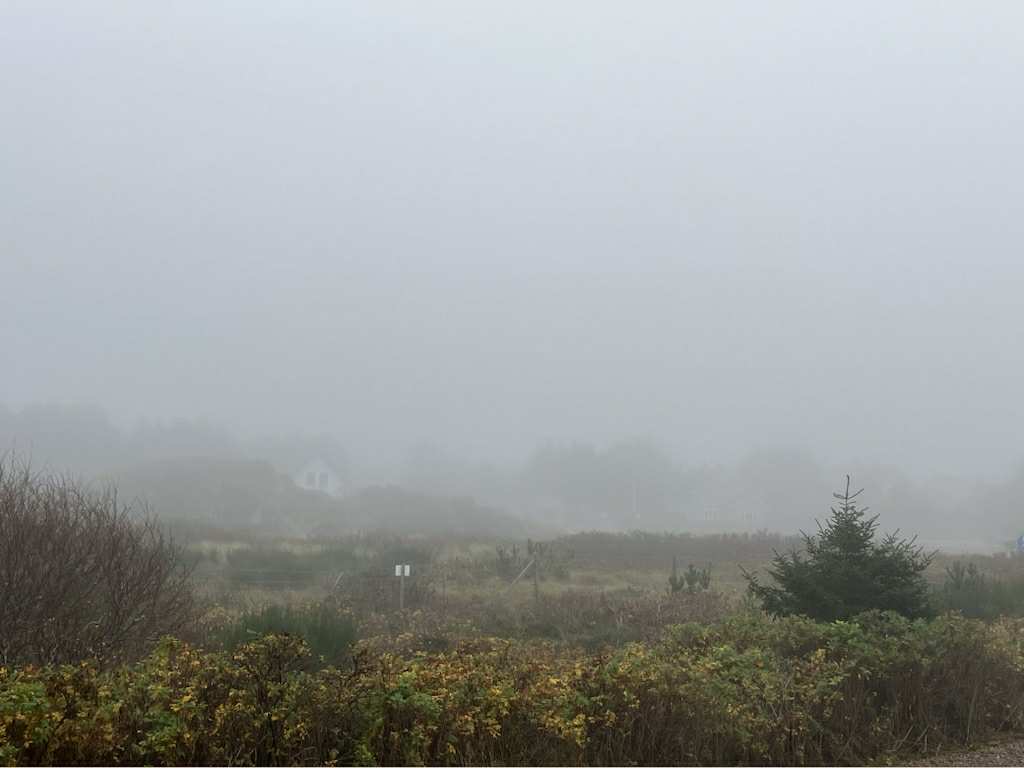
Stationen forsvandt også i tågerne set fra fyrets højdepunkt - så heldigt at jeg kan vejen udenad! Billede: Mathilde Lundt Larsen
Med tågens bølger fulgte mest solsorte, som vi fik syv af i nettene i dag. Mange andre fugle blev det ikke til, men et par genfangster kom der. Sidst på dagen fik jeg en fin sortmejse 1k han, som med sit lille hvide 'øjenbryn' mindede mig om den tid tidligere på sæsonen, hvor vi havde mange sortmejser (før blåmejserne..).
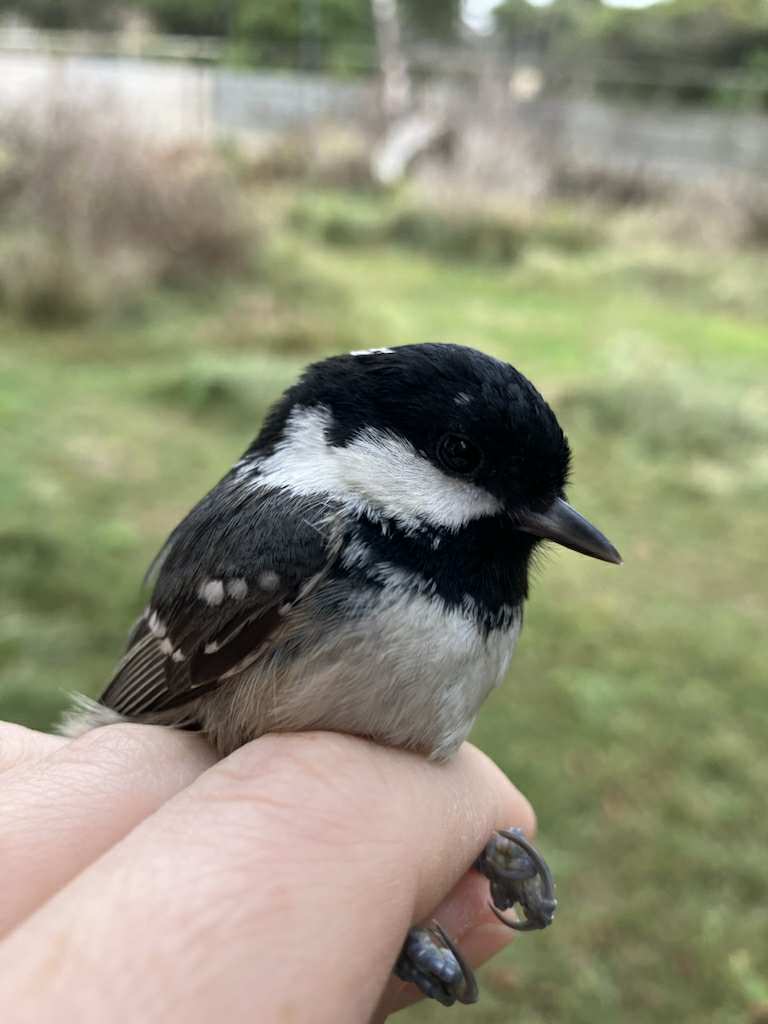
Sortmejse 1k han. Billede: Mathilde Lundt Larsen
Vi kunne således bruge en tåget eftermiddag på at tjekke sæsonens data igennem, som forberedelse på sæsonens afslutning ved udgangen af denne uge. Tænk engang, at vi allerede nærmer os!
En tåget dag i Blåvand blev en stille men god novemberdag på det vestligste punkt.
- MLL
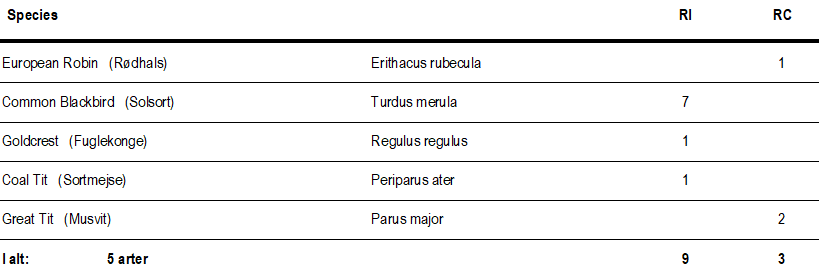
Folk på stationen: Lua Koplin, Sverre Dahl Porsgaard, Mathilde Lundt Larsen, Oliver Laursen
A pecking goodbye!
Morning obs:
We woke up to it being quite misty and damp, leaving us without much hope for the day. And the first couple of intervals were also very boring with just 5 or so species. However when Thomas arrived he also arrived with the birds, because the mist lifted a little allowing us to see more birds, such as the red-throated diver and the black scooters. A couple of odd species also arrived such as the common merganser, common goldeneye and snow buntings that lifted the day a little. The mist made it so that the birds that we saw were very close allowing us to see greater details on the birds, than if they were father away. But the bird of the day will have to go to the snow bunting that called with its beautiful whistle and nice white wings.
Ringing:
The morning started quite misty, which turned out to be very fortunate for us since by the first round we already had gotten more then 10 birds! While most of the were blackbirds, we had one very special one and first for me (Lua) at this station, a beautiful first year female fieldfare!

As the day moved on, we had to say goodbye to Selina, who left mid morning, but not without a special bird to sweeten the goodbye, a beautiful young female woodpecker!
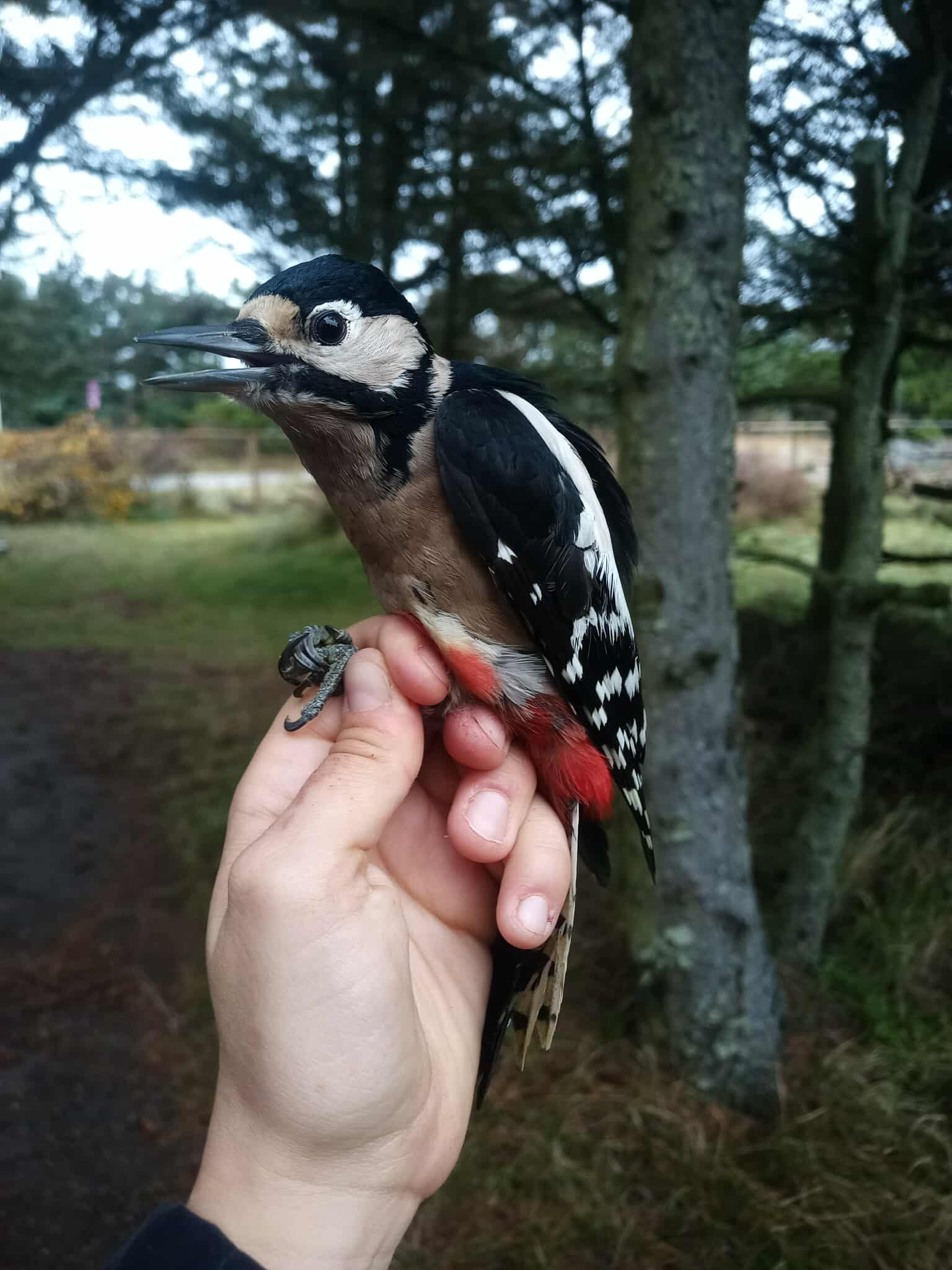
No screams but a lot of angry stares! As this ringing day started to slow down and we were considering closing all the nets, Oliver, who was in the house, came out to the station garden, pointing out a bird to us that he had seen from the window, a stunning firecrest, who we caught a round later! As the last bird, it was a real sweet treat for all of us!
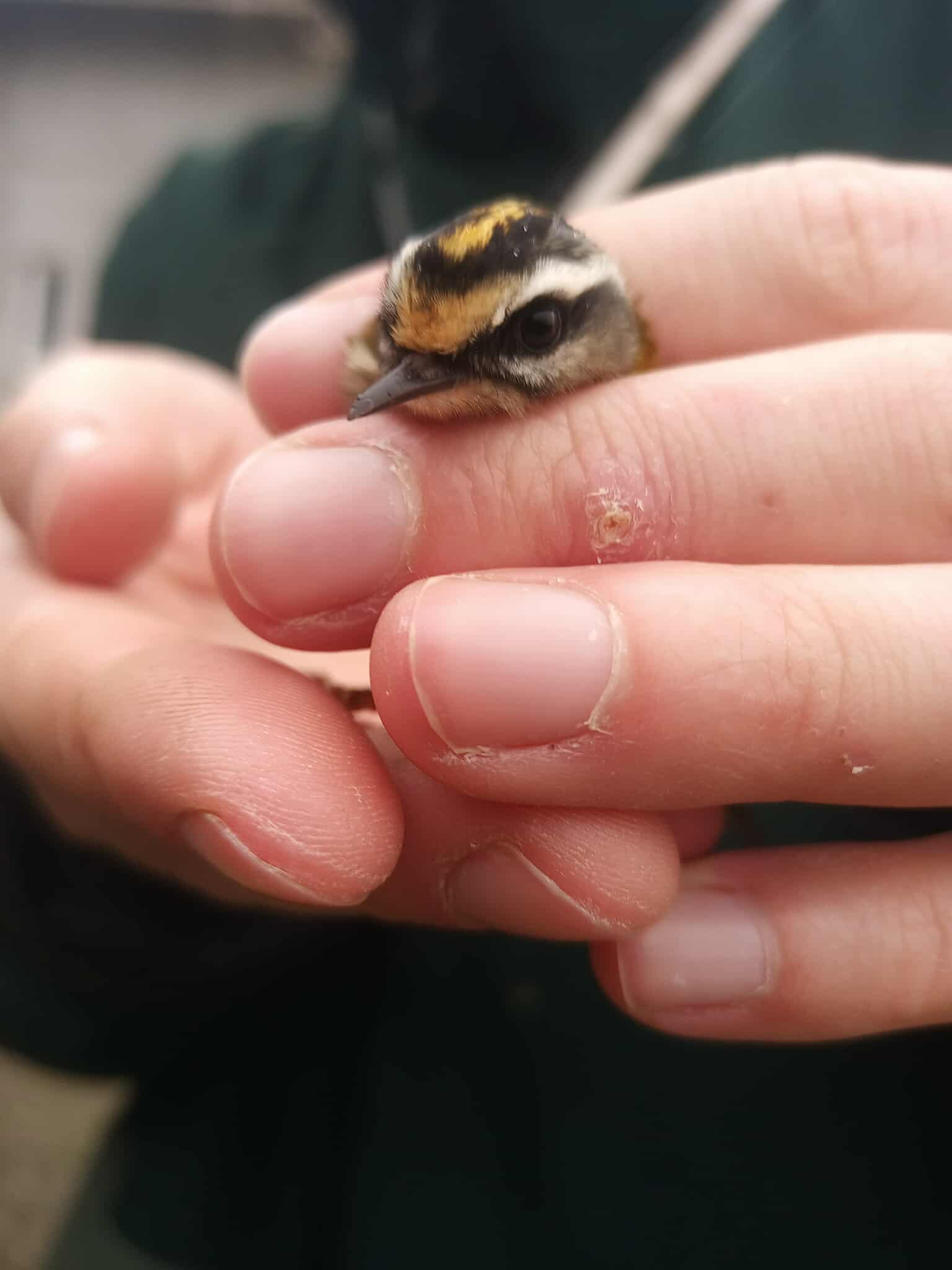
-LK
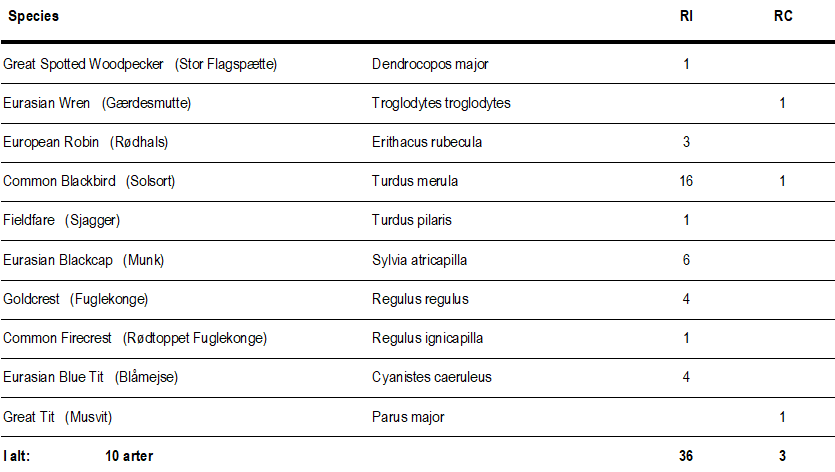
Folk på stationen: Lua Koplin, Sverre Dahl Porsgaard, Mathilde Lundt Larsen, Oliver Laursen, Selina Veng, Henrik Böhmer, Thomas Kristensen
Vi kunne godt bruge en større hånd
Morgenobs
Vejret er gråt og overskyet, tågen buldrer ind fra både havet og mosen og vinden blæser med sølle 3 sekundmeter fra næsten stik øst. Heldigvis er der stadig relativt lunt for en novemberdag og jeg (Sverre) havde godt selskab med både Oliver og Thomas på obs-posten. Allerede på vej mod min trofaste observations-klit blev jeg mødt af en blå kærhøg som lige havde været ude og vende over vandet inden den gav op og fløj tilbage over mosen. Foruden den enlige kærhøg bød dagen på en bitte smule spurvehøge og en rastende musvåge. Der kom lidt pibeænder, lidt over treds grågås og to kortnæbbede gæs som hvilede sig på stranden inden de fløj længere sydpå. Blandt anseriformerne blev dagens fugl en gruppe på fem lækre hvinand hanner som trak støt og roligt mod syd. Det gode ved alt den her tåge er at den presser mange af fuglene tættere på os, så vi kan nyde dem bedre... derudover kan jeg hilse og sige at vi har rigeligt tid til den enkelte fugl sådan en dag som i dag.
Oliver fandt endnu en lækker sortstrubet lom som også hvar ganske fin. En stille men hyggelig dag her på hukket. I morgen blive nok lidt lig denne men måske lidt mere tjep da vinden går mere i vest:)
- SDP
Ringmærkning
Dagen gryede langsomt og uigennemtrængeligt gennem gårsdagens tykke tåge. Tågen holdt ved gennem hele dagen og afgav dugdråber i luften. Det var næsten som om, tiden stod stille denne morgen, mens det blev lyst ved netåbning. Samtidig gav de helt vindstille betingelser gode ringmærkningsmuligheder op af dagen.
Dette viste sig ved en fin artsdiversitet på sådan en novemberdag - især solsortene er taget til. Jeg så og hørte også en del drosler (sangdrosler, vindrosler og sjaggere) rundt i krattene mellem netrunderne, men vi fik dog kun en enkelt vindrossel i nettet.
Dagens store overraskelse ramte på anden netrunde i fyrhaven, da jeg i begyndelsen af runden fik øje på en stor fugl og løb for at gribe den, hvis den nu skulle fare ud af nettet igen. Imidlertid forblev fuglen rimelig stille i nettet - og det viste sig, da jeg kom til den, at det var en skovsneppe! Da jeg så næbbet og de store øjne, blev jeg meget begejstret, da dette er uden tvivl en af mine personlige yndlingsfugle. Det viste sig ved aldersbestemmelse at være en 1k fugl, måske på vej på træk fra havet, da den fløj ind i nettet fra strandsiden. Sådan en skovsneppe vejer over 300 gram!
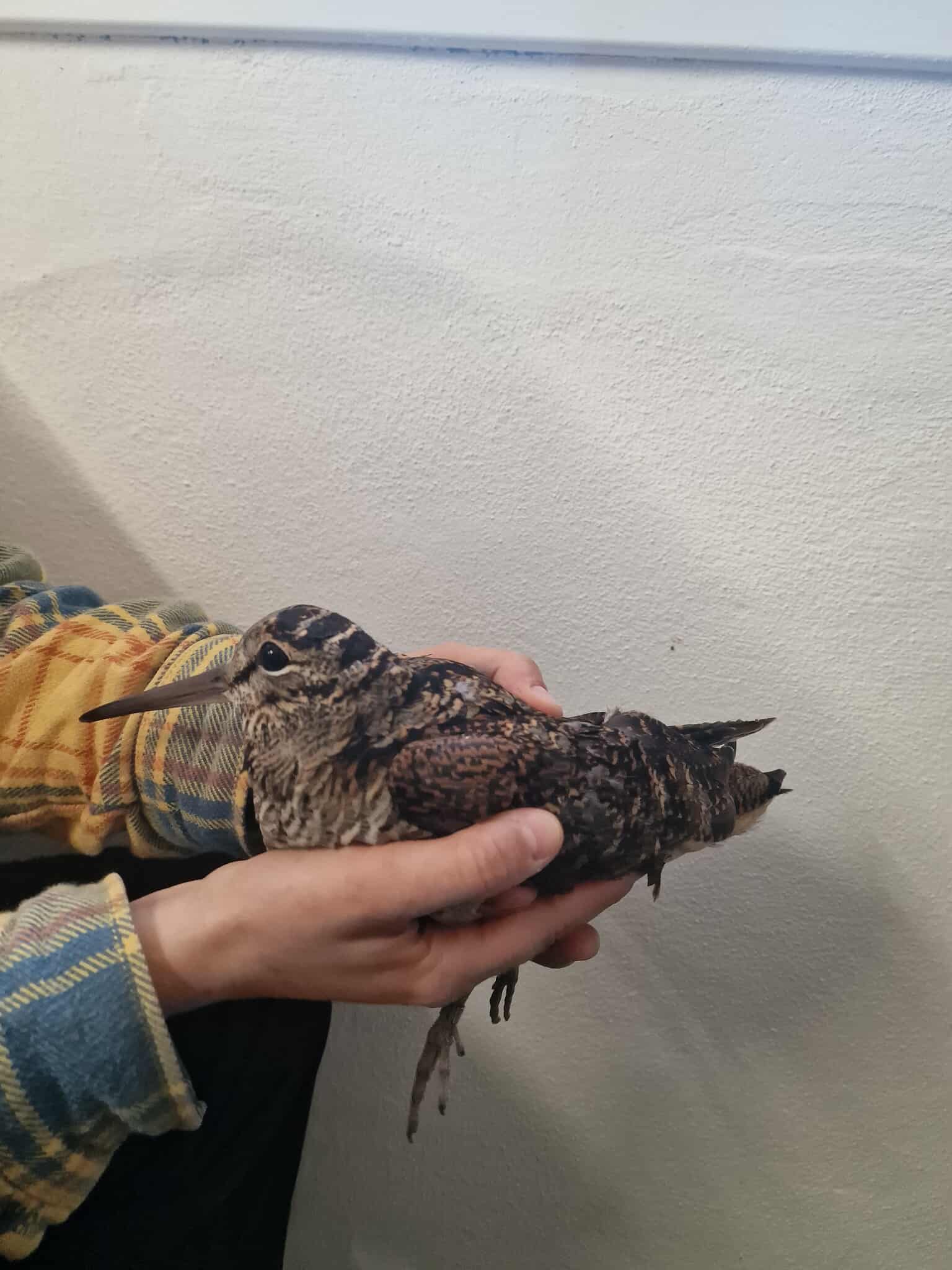
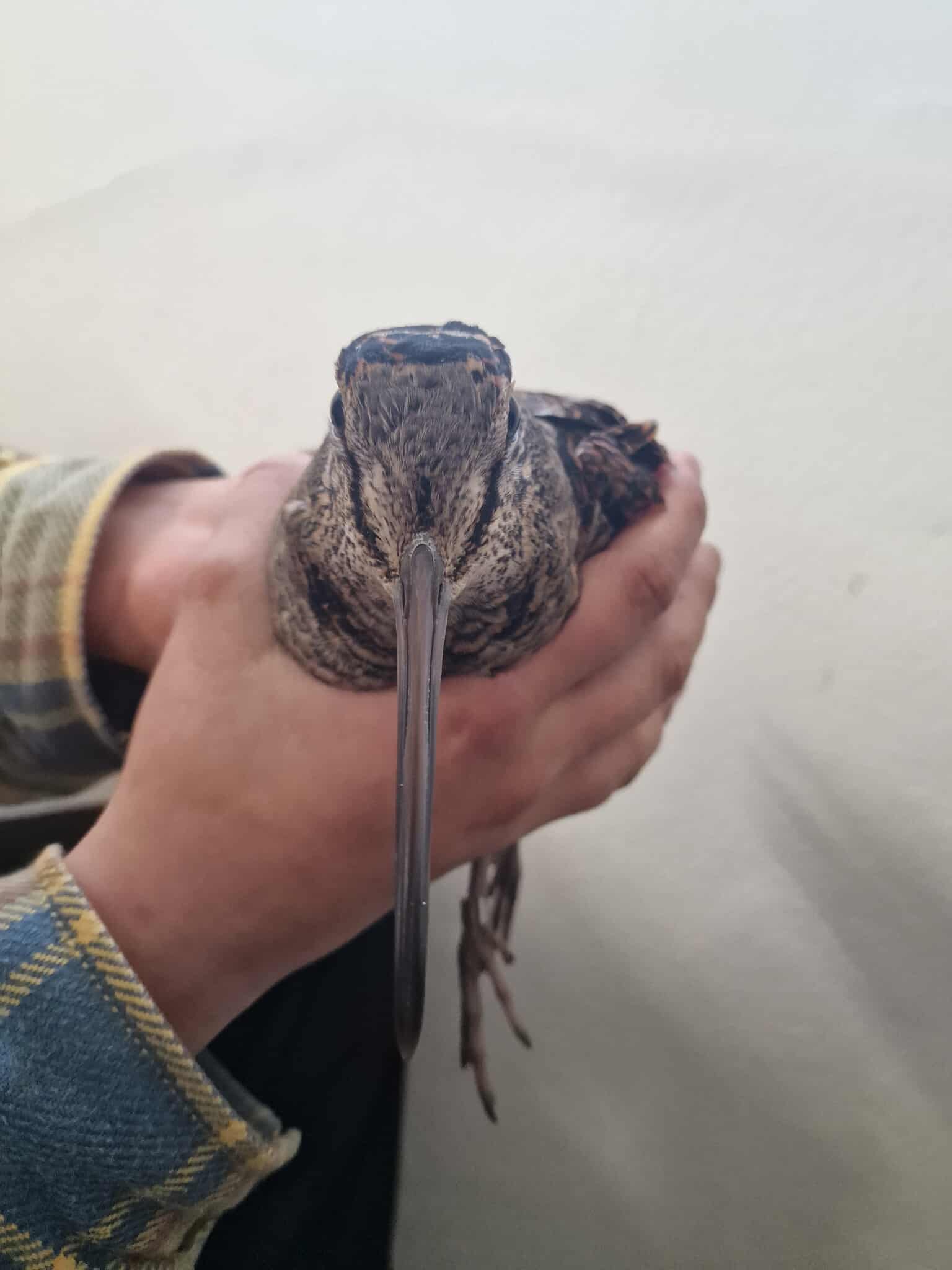
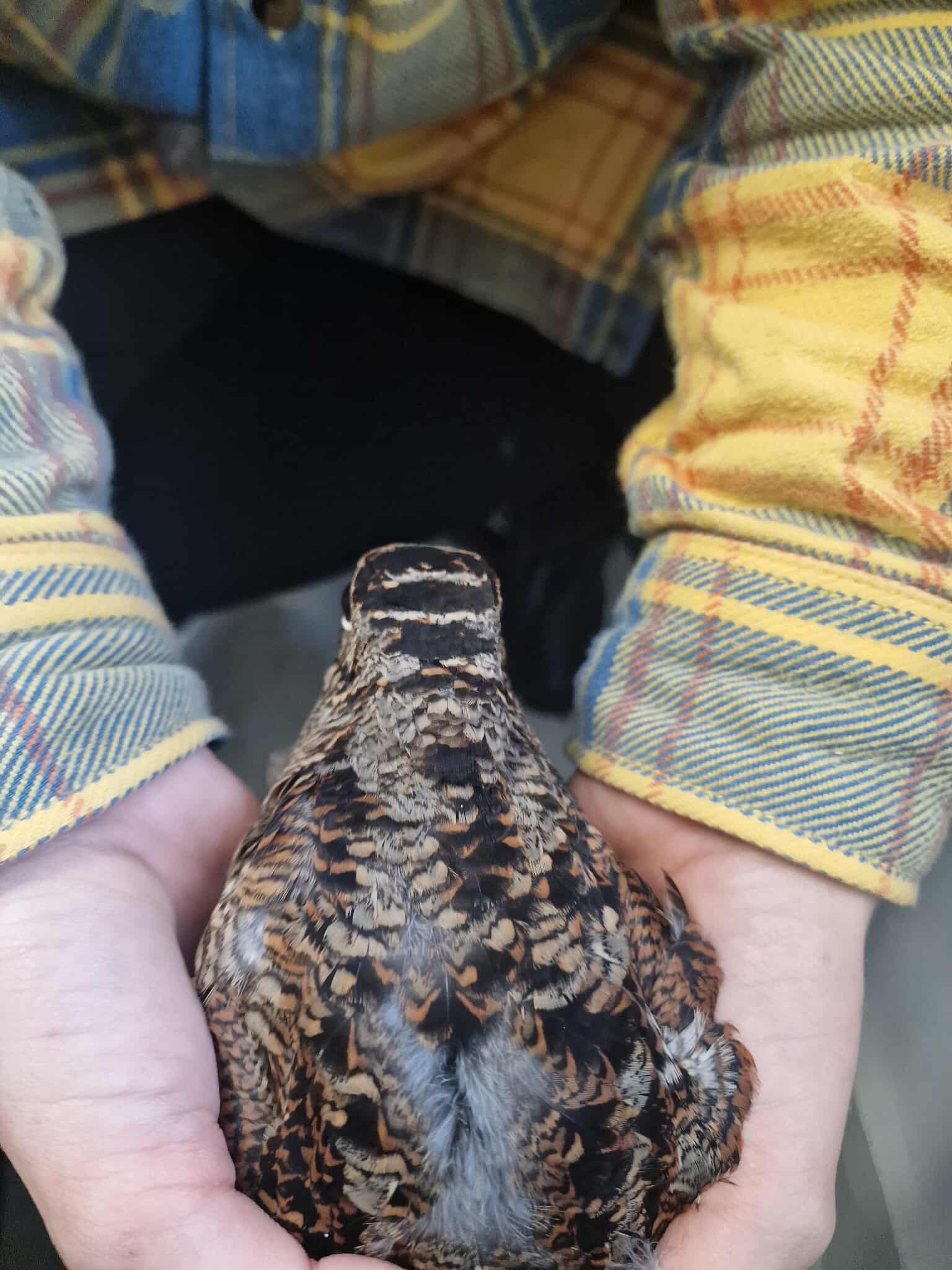
Skovsneppens store øjne - den har 360 graders syn! Billeder: Sverre Dahl Porsgaard
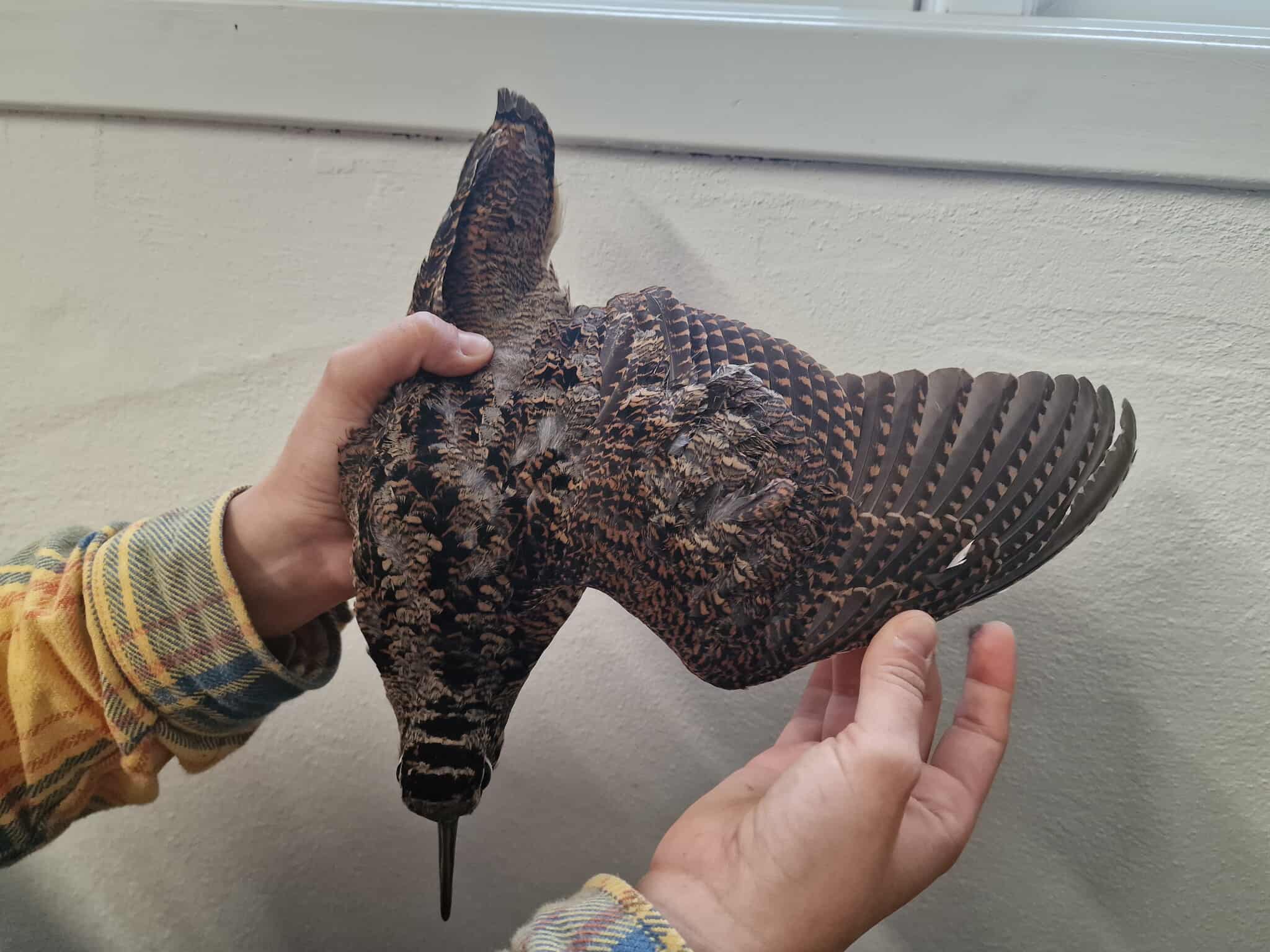
Skovsneppens vinge vises frem til alderbestemmelse. Billede: Sverre Dahl Porsgaard
Senere på dagen fik vi endnu en stor fugl i nettet, efter det stilnede lidt af - en 1k spurvehøg hun. Hunnerne hos spurvehøge er større end hannerne, og dette kunne ses på denne, især ved vejningen. De intense gule øjne stirrede mig ned under ringmærkningen.
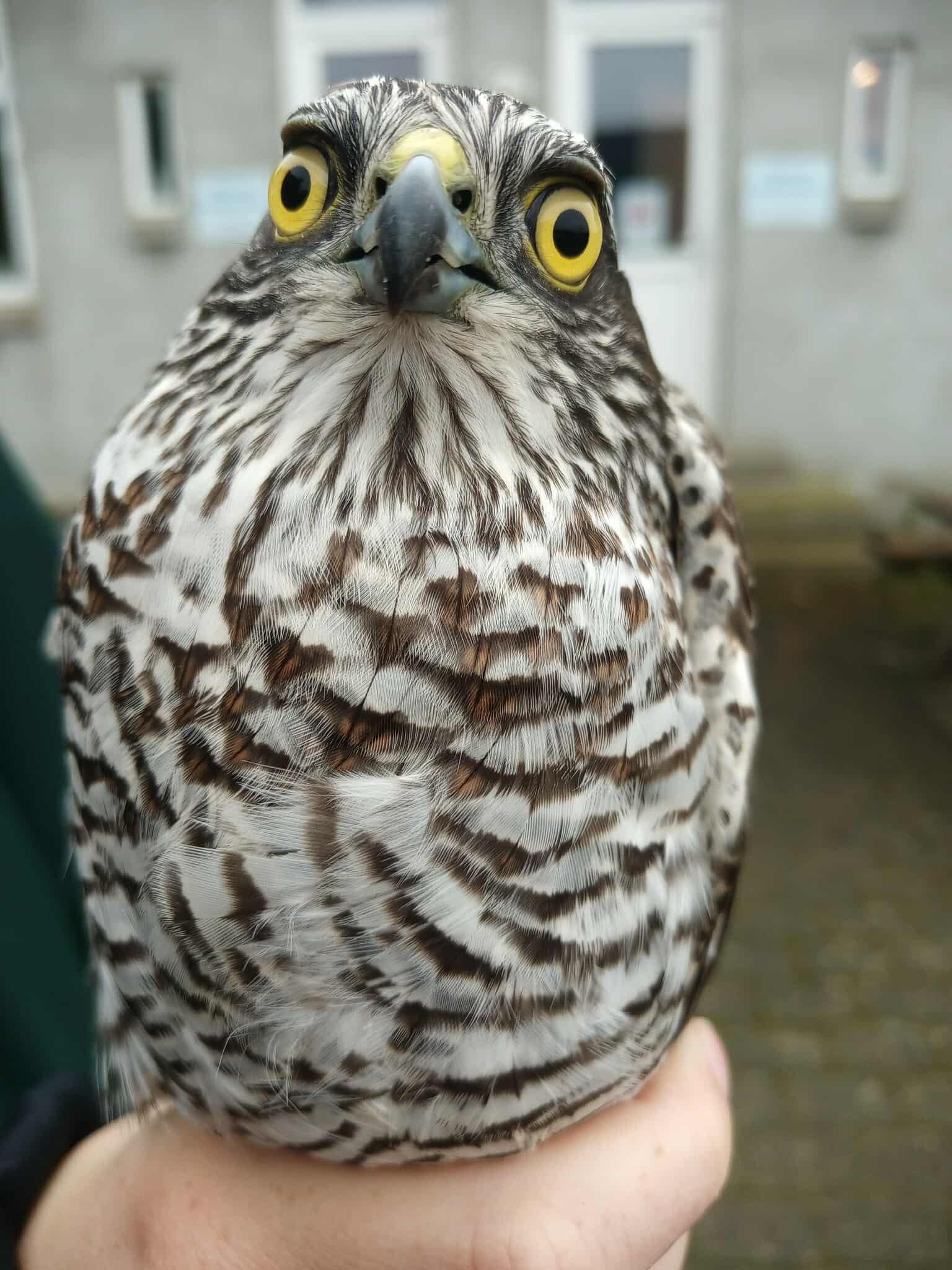
Spurvehøg 1k hun. Billede: Lua Koplin
En tåget dag endte også, da mørket faldt på i langsom ro.
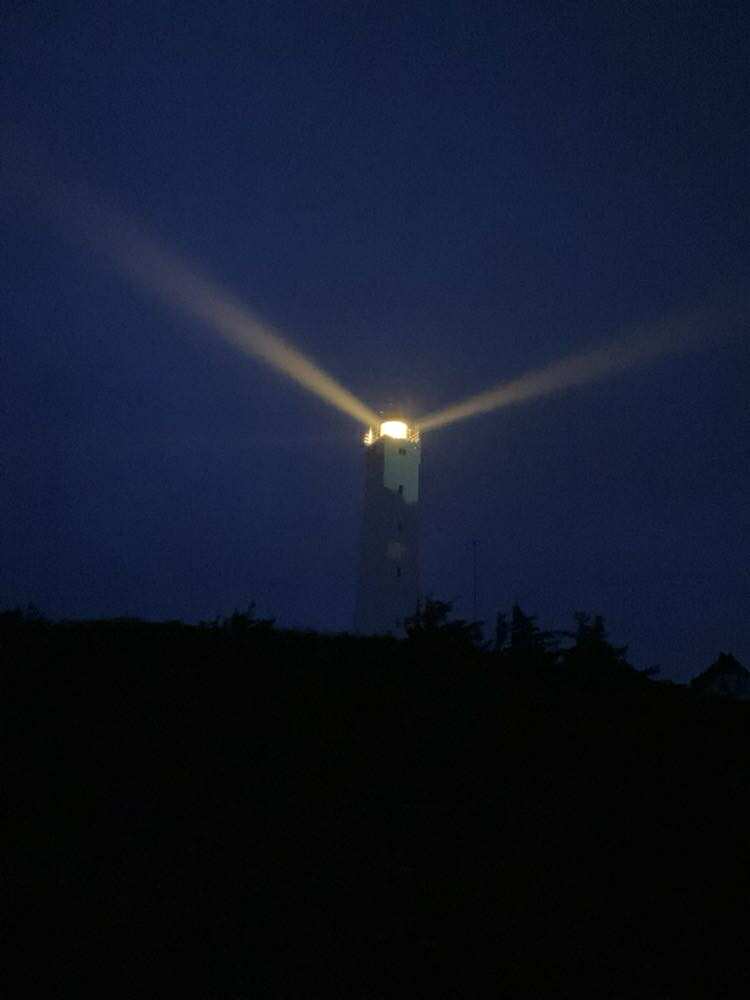
Blåvand Fyr efter mørkets frembrud. Billede: Mathilde Lundt Larsen
- MLL
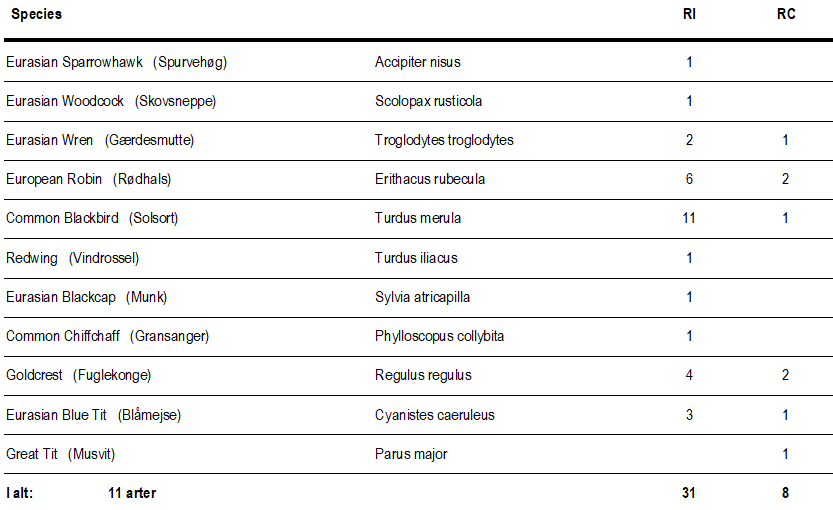
Folk på stationen: Lua Koplin, Sverre Dahl Porsgaard, Mathilde Lundt Larsen, Oliver Laursen, Selina Veng, Henrik Böhmer, Thomas Kristensen
Not a gloomy BUT a loony day!
Morning Observation
This November day gave us a heads up for what is to come in the coming days. Once November really hits the birds stop in their footsteps and the migration slows down. Today however we were quite pleased, with birds like pink footed goose, barnacle goose and black-throated loon. The loon was the first one we have had out here in a while, so we were quite pleased when we saw those white spots going up its back on each side, showing it was inddeed a black-throated loon. Soon after the migration slowed down allot giving us an insight to the days that are to come. This is not to say there were not birds to thrill us. The starlings that arrived in fairly large flocks flew like a big band right over our heads, allowing us to hear the wingflaps, almost like a mini 'black sun'. We saw the day as a succes at the end of the day and we later went to twitch the red pharalope however without any succes.
-OLA
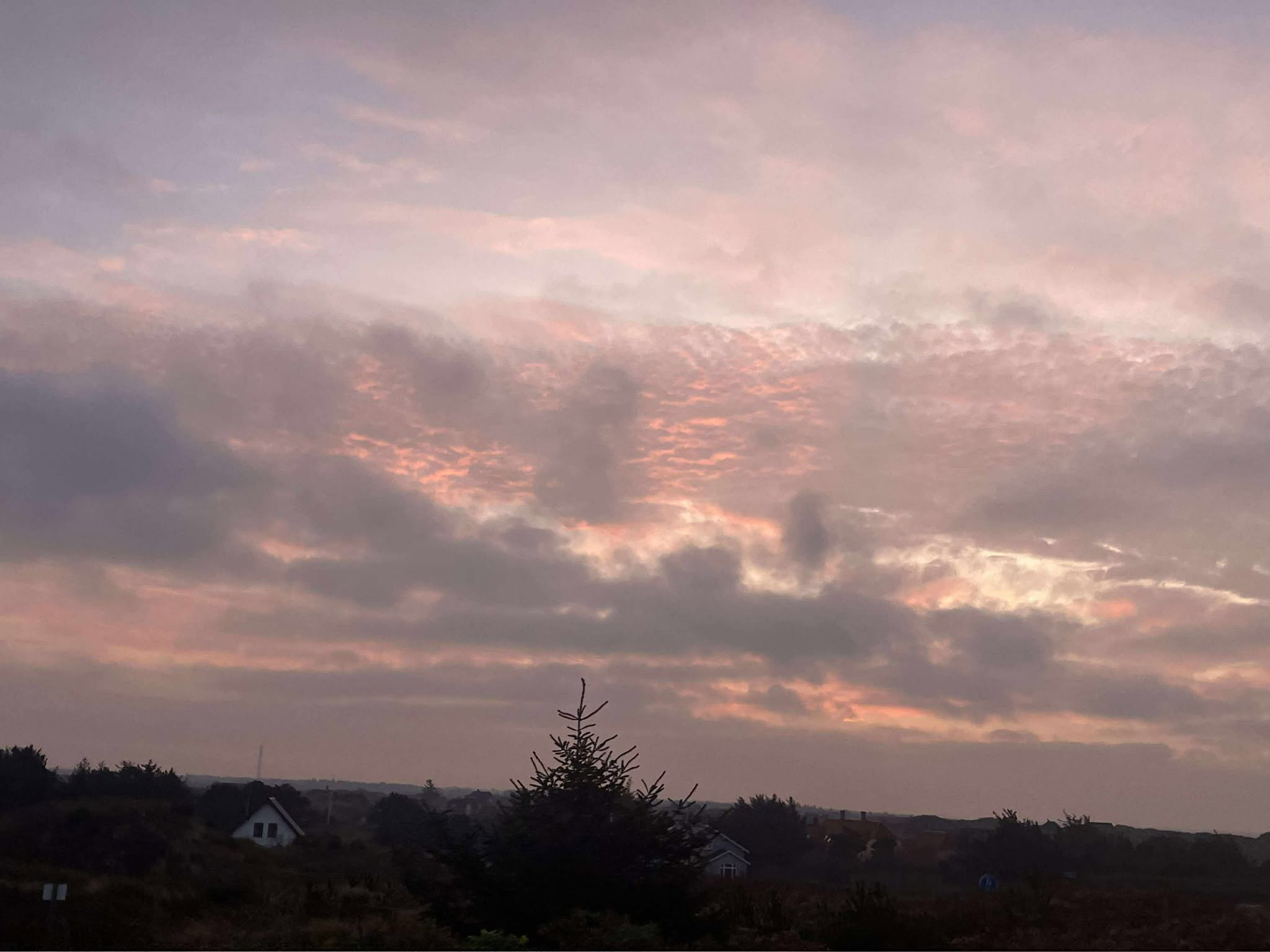
Another beautiful morning in Blåvand
Ringing
This morning the weather conditions for ringing were almost perfect, however bird activity dropped when the fog rolled in. No blue monsters today, but alot of blackcaps and blackbirds instead! We had 2 interesting recaptures and a lot of practice opportunity for Selina! For me, the bird of the day was this tiny little goldcrest, with only 4.4 grams to it's name!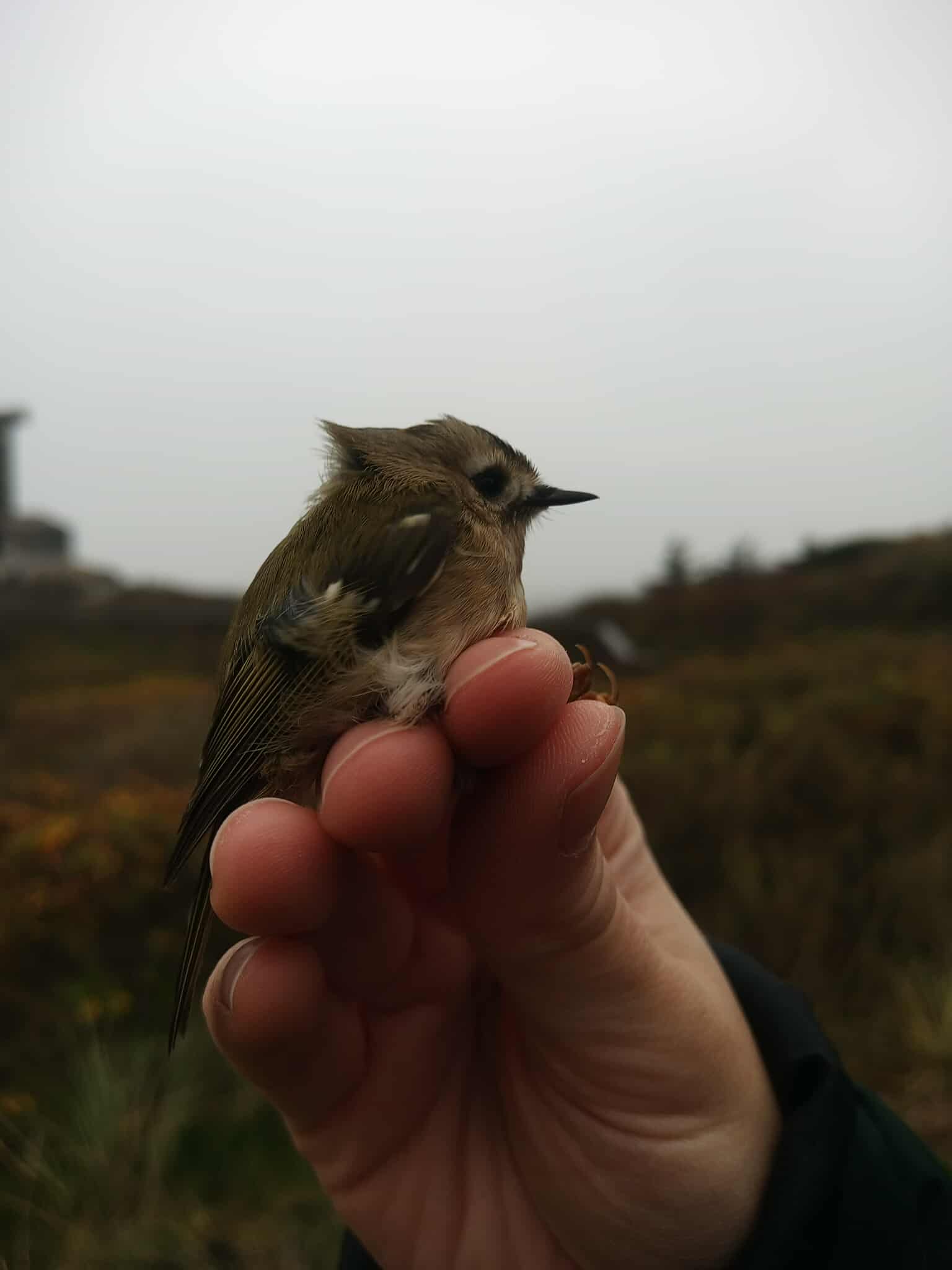
Small goldcrest getting surprised by the wind
We then got this beautiful couple of chaffinches, the male having been a recapture from the beginning of the autumn season in Agust! 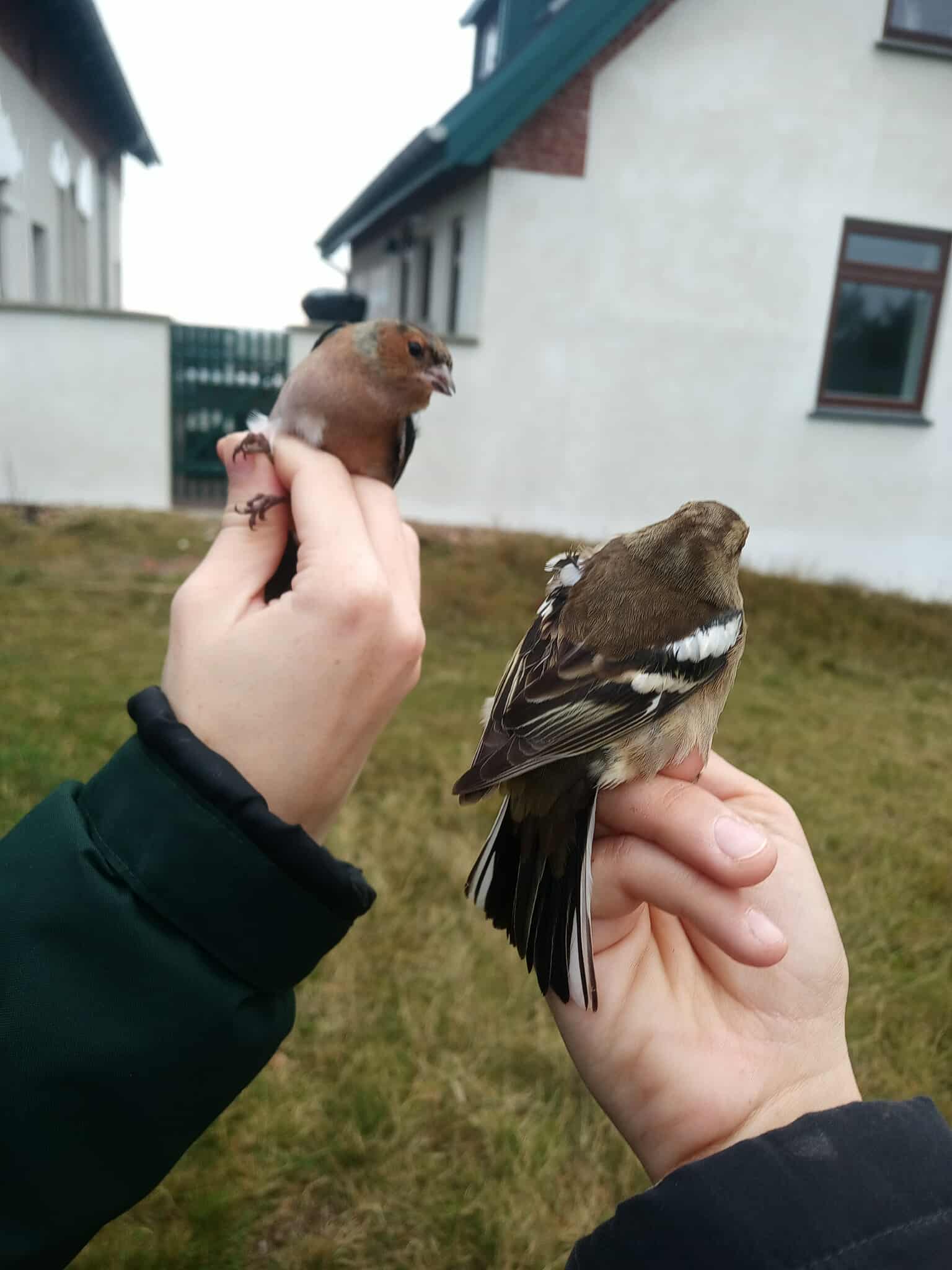
Chaffinch couple ready for release
As one of our last birds today, we had this late chiffchaff, always a joy to teach about how to tell them apart from willow warblers! You can tell by the number of notches on the primarys, the chiffchaff having on six primary feathers and the willow warbler only on five!
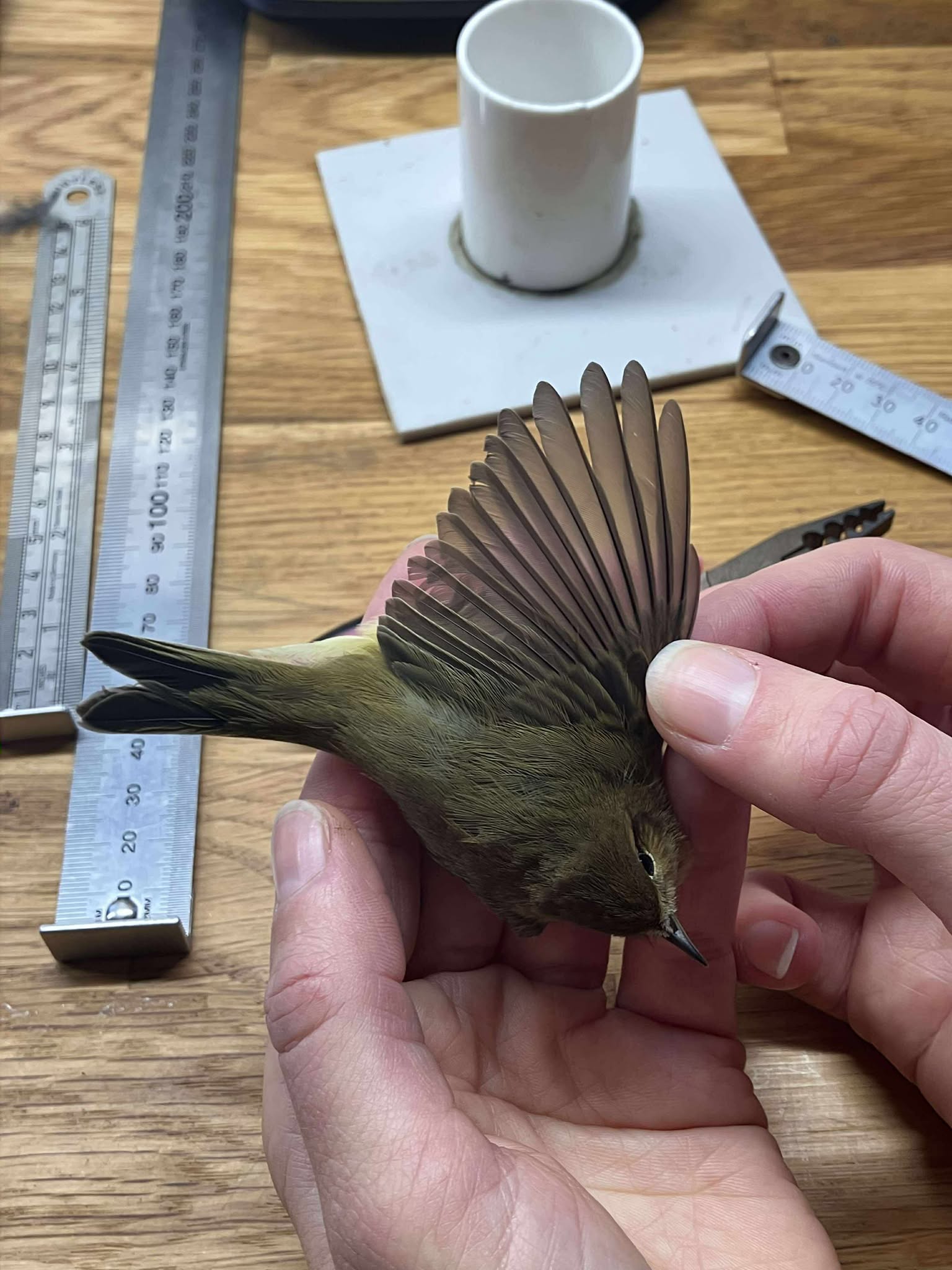
Chiffchaff IDing session
-LK
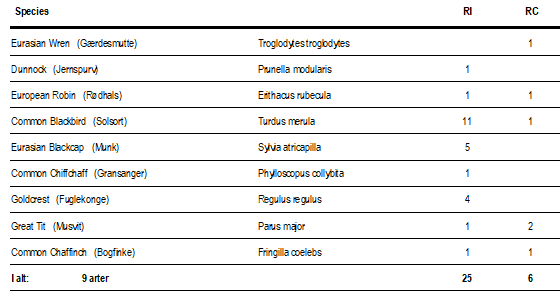
Folk på stationen: Lua Koplin, Sverre Dahl Porsgaard, Mathilde Lundt Larsen, Oliver Laursen, Selina Veng, Henrik Böhmer, Sverres bedstemor Kirsten
Sæsonens, hvis ikke årets, bedste fugl!!
Morgenobs
På nuværende tidspunkt har i sikkert læst dagens overskrift og ved at der er sket noget sindssygt spændende i Blåvand. Jeg vil ikke løfte sløret helt endnu, man lade jer hænge lidt på en cliffhanger.
Dagen startede nemlig på klassisk november maner med sydøstenvind og en halv stille morgen. Lunt og dejligt, godt med ederfugle, over to hundrede bramgås og 45 kortnæbbede gæs samt hele to flokke på fem fløjlsænder i hver. Bestemt ikke værst. Allerede kl 09 begyndte bombadementet af beskeder, på kommunikations appen Zello, fra stationslederen Henrik Böhmer. Han meldte først en hvidbrynet løvsanger og en fuglekongesanger ud fra det lange krat på grønningen. Utrolig lækre semisjældne sibiriske fugle, men utroligt nok ikke dagens højdepunkt. Henrik kommer med endnu en besked, han har en sjov sanger som sidder og småsmasker lidt i krattet. Måske en schwarz løvsanger... Der går lidt tid og så kommer meldingen som får det til at løbe koldt ned ad ryggen på os. Han har både klokkeklare kald optaget og et utroligt godt billede til identifikation. Det er intet mindre end en CETTI SANGER!! Kun andet fund for landet, hvor den første blev ringmærket i skagen. Så den første Cetti sanger udenfor net. Henrik har lige lagt sæsonen største guldæg! Jeg må ærlig indrømme at Oliver og jeg havde svært ved at tælle sortænder efter dette. Tankerne var sjovt nok andet steds. Vi pakker hurtigst muligt sammen og fræser ned mod grønningen for at se den sjældne fugl. Kort efter kommer Mathilde drønende med en sand fuglekiggers drift, hun har praktisk talt indhentet bilen og kan køre cyklen direkte ud i mudderet. Henrik står og modtager os og vi hører alle den karakteristiske smaskende kald efterfulgt af en blød trillen lidt alla en lækker version af en gærdesmuttes. Vi ser den desværre ikke, da det er en enormt sky art. Men vi er heldige nok til at være blandt de første fem på pletten inden alle twitcherne kommer og koruperer de gode lydfiler med småsnak. En absolut fantastisk fugl og absolut sæsonen mest interessante fund!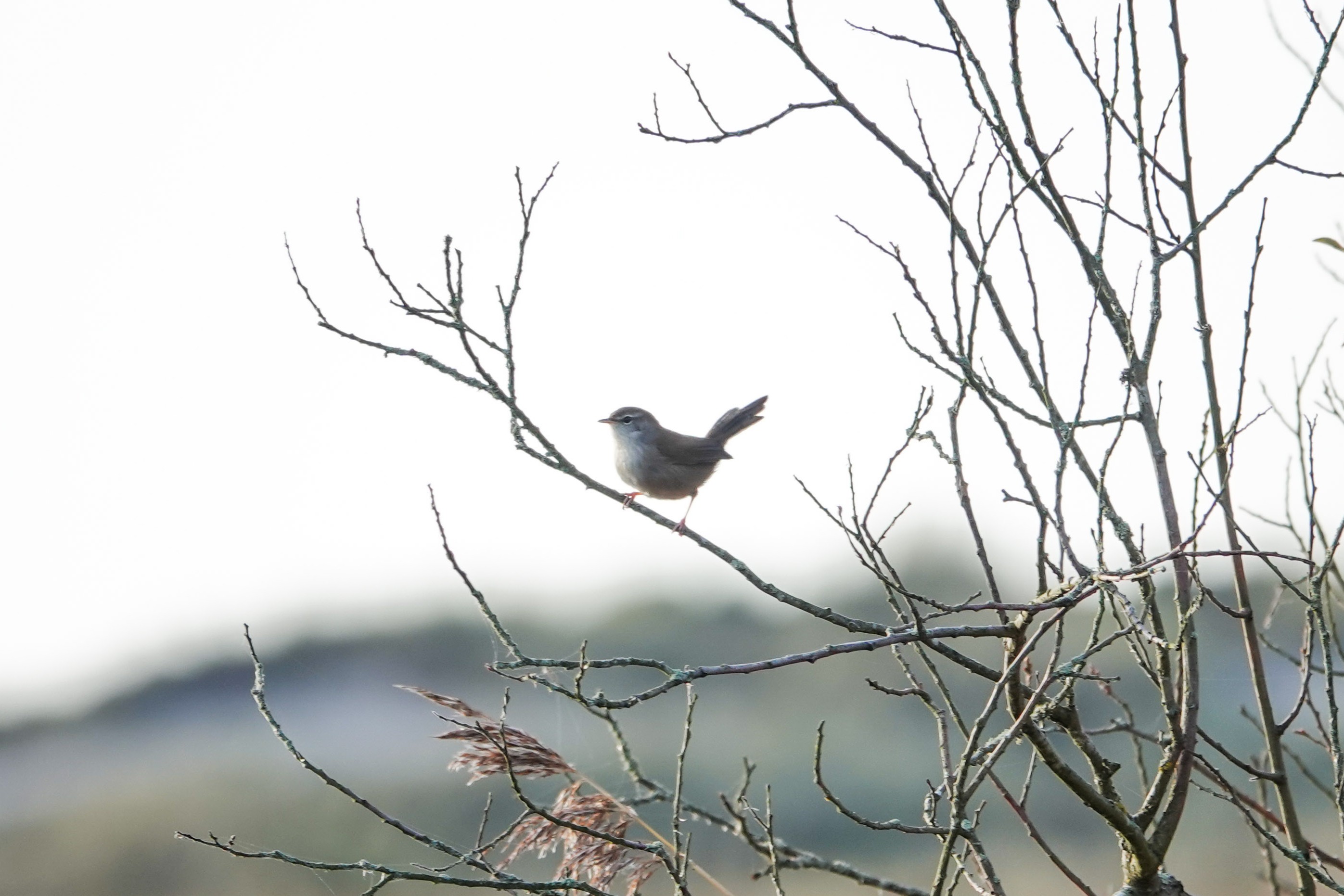
Måske årets bedste fugl, en Cetti sanger. Foto; Henrik Böhmer
Dagen er dog ikke slut endnu. Min (Sverre) bedstemor er ankommet til Blåvand for at besøge mig og se hvad jeg bruger tiden på herude vestpå. Jeg mødes med hende, lige tidsnok til at høre Henrik kalde en Thorshane ud et andet sted på grønningen. Den er rastende og ligger i en smuk glorificeret vandpyt. Den venter pænt på at min bedstemor og jeg, samt resten af hr og fru danmarks fugleverden ankommer. Jeg ser den halvdårligt da det går op for mig at jeg har glemt mit teleskop på stationen i min iver for at se Cetti. Bent Jakobsen ankommer heldigvis hurtigt til svømmesneppen og låner mig sit teleskop, hvorefter jeg tager et hurtigt billede til jer. Endnu en lækker fugl i dag.
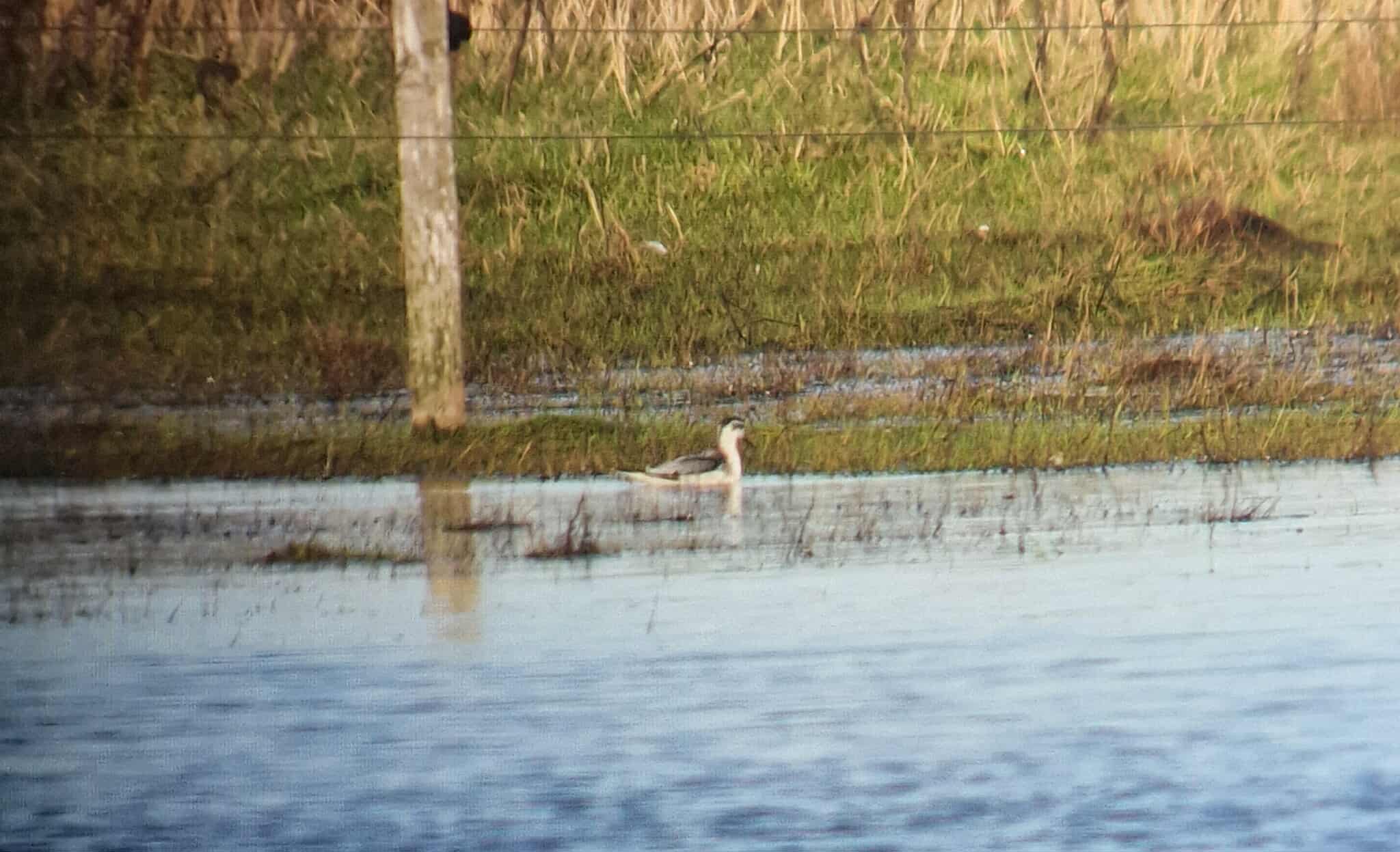
Den lækre Thorshane. Foto; Sverre Dahl Porsgaard
Imellem siberiske sangere, Cetti og svømmesneppen finder Henrik selvfølgelig også en bjergpiber. Endnu en semisjælden fugl, dog mere udbredt end de andre her på grønningen. Med de førnævnte rariteter og himalaya sangeren i tipmosen (som stadig var at finde i dag) er der således fire subhits og to SU-arter i blåvand i dag! Til de fuglekiggere som ikke fik Cetti sangeren i dag skal dog nævnes at ved nærmere lydanalyse har Henrik optaget et kald fra den allerede i mandags, så den kan sagtens tænkes at blive i området lidt endnu;)
I dag var i sandhed en fantastisk dag at være på fuglestationen! Endnu en god dag i Blåvand.
- SDP
Ringmærkning
Efter et par grå morgener, stod vi op til en smuk lyserød solopgang. Det gjorde os spændte på hvad morgenen ville bringe af fugle i nettet - og vi blev ikke skuffede!
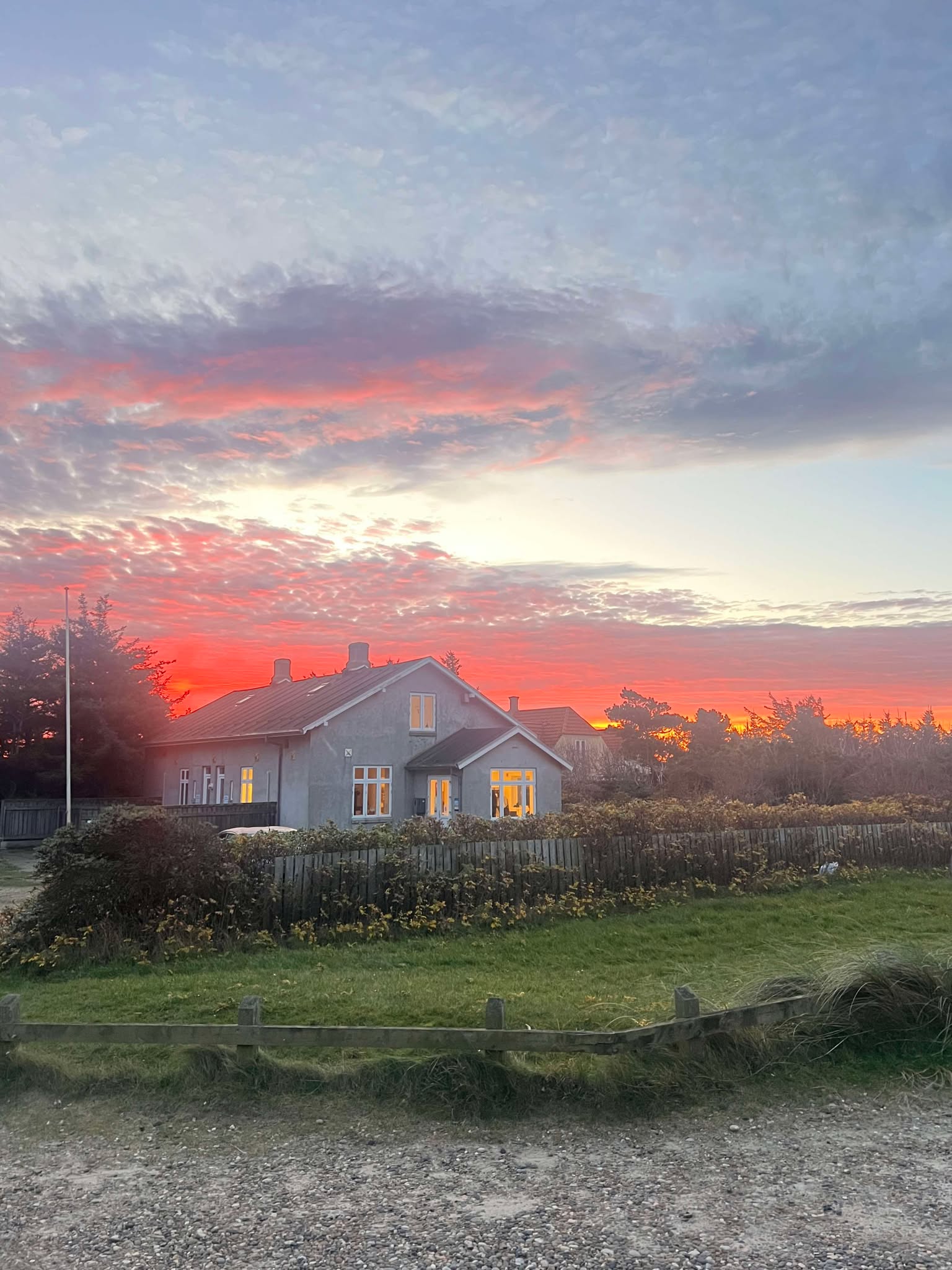
Smuk solopgang over stationen. En ny dag gryr i Blåvand.
Efter et par stille og rolige runder, var der pludselig et net fyldt med blåmejser. Vi kiggede på vores stadig let medtagne fingre og blev lidt nervøse. Får vi en 400 blåmejser-dag igen? Det blev dog ikke til den helt samme blåmejseoverflod. Fordelt på et par timer, kom vi op på 101. Fedt!
Senere blev vi beriget med en nuttet flok svenske halemejser. Gruppen bestod af både den nordlige og sydlige underart, og en af dem havde altså en ring der stod "Stockholm" på! Det er altid sjovt at kunne se dem side om side til sammenligning.
- SV
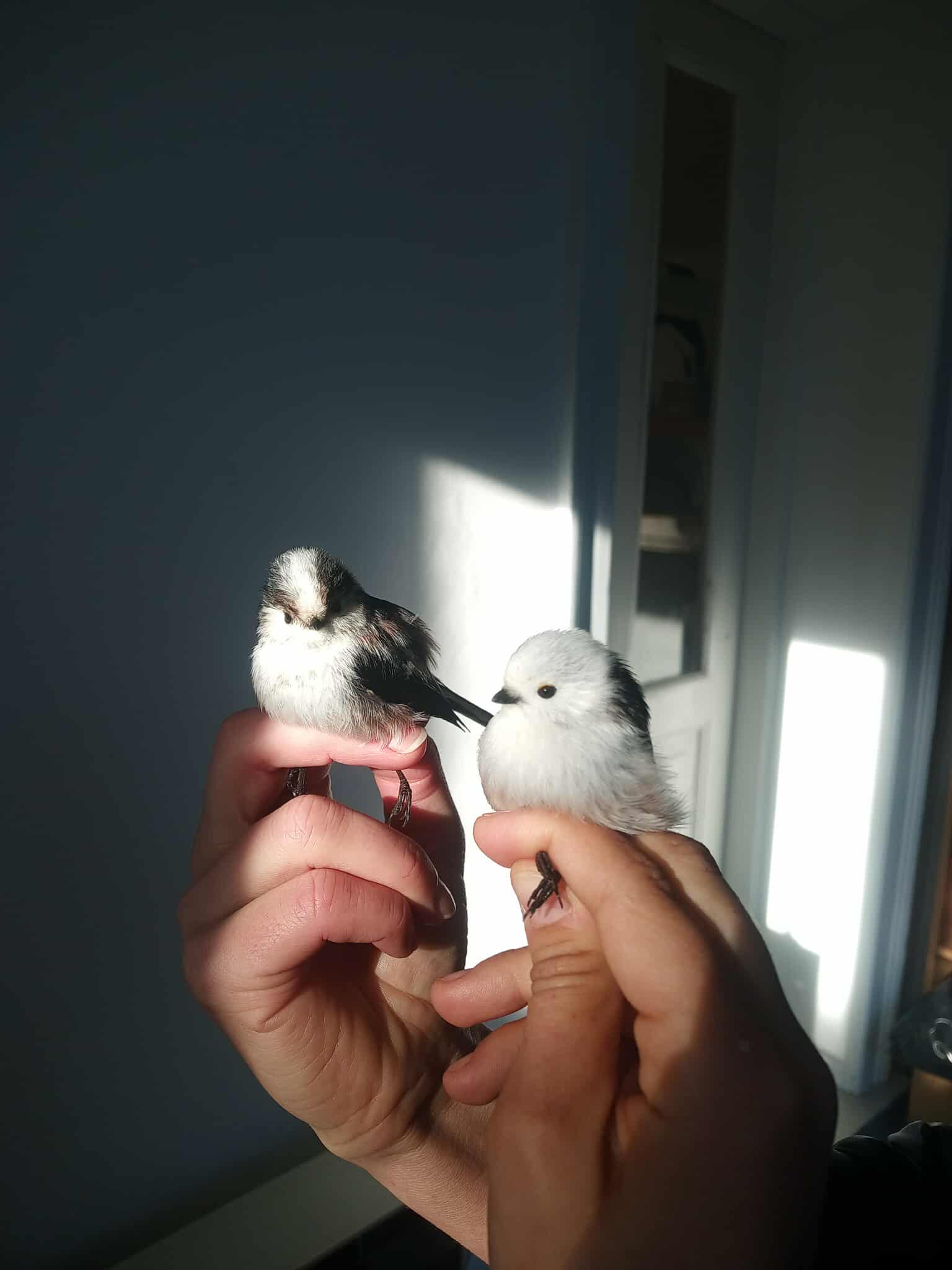
Halemejser - sydlig til venstre og nordlig til højre for sammenligning.
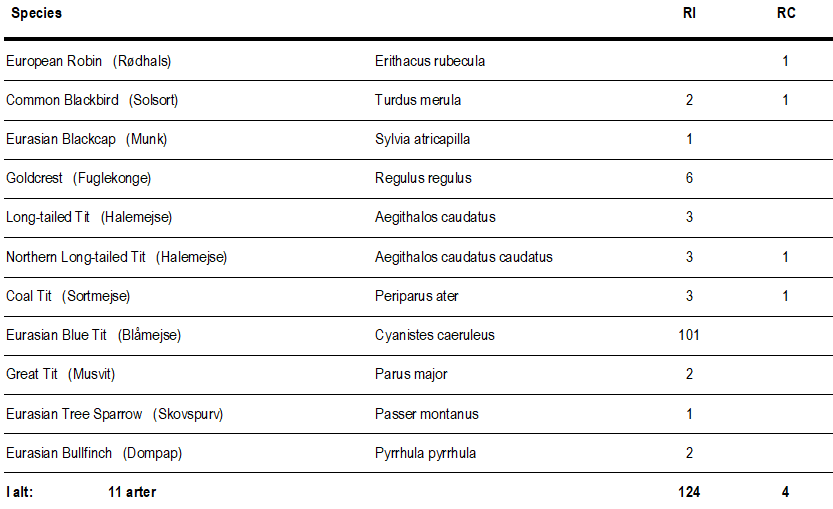
Folk på stationen: Lua Koplin, Sverre Dahl Porsgaard, Mathilde Lundt Larsen, Oliver Laursen, Selina Veng, Thomas Kristensen, Bent Jakobsen, Henrik Böhmer, Sverres bedstemor Kirsten



